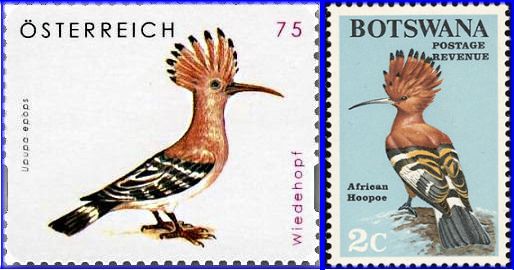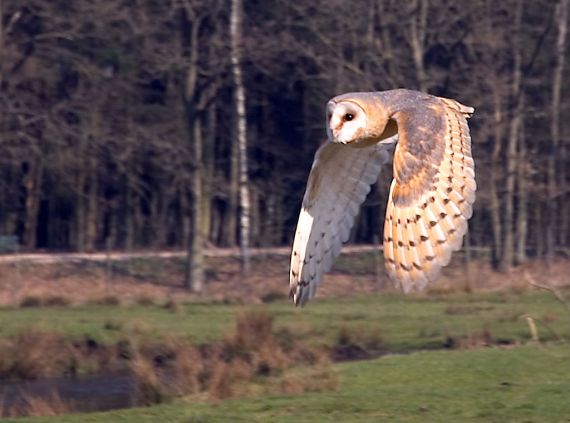Bible Birds
This page was originally published in August-October of 2016.
It has been altered to fit a single-page structure.
Part I – What About that Dove? & Factoid: Gilgamesh
Part II – Sandgrouse or Quail? & Factoid: YHVH [יְהוָ֖ה] [Yahweh]
Part III – Junglefowl in Judea! & Factoid: New Testament Koine Greek
Part IV – Birds that Sow, Reap and Store & Factoid: Whence Jesus (Ἰησοῦς)
Part V – The Friendly Ravens & Factoid: The Bar-Abbas Mystery
Part VI – The Humble Hoopoe & Factoid: Catching “Forty” Winks
Part VII – The Wise Hoopoe & Factoid: On “On”
Part VIII –Don’t Eat That Bird! Part 1 & Factoid: Of “Of”
Part IX – Don’t Eat that Bird! Part 2 & Factoid: Seeing “Red”
Part X – Don’t Eat that Bird! The Last Bite & Factoid: Problems of Translation
[Chuck Almdale]
Sunday Morning Bible Bird Study I:
What About That Dove?
Whatever one may think of the bible, it was inarguably written long ago by humans not significantly different than us, who wrote about what they knew and what they imagined, just as we do today. Any mention of a bird means – at a minimum – the writers had noticed them, however little they might have to say about them, or however accurate it might be. In this series, we begin with what the bible says about birds, to which we add what we’ve learned over the centuries since then, to see if we can uncover anything new and interesting. Each essay begins with a citation; we start in the beginning, with Genesis, the first book of the bible.
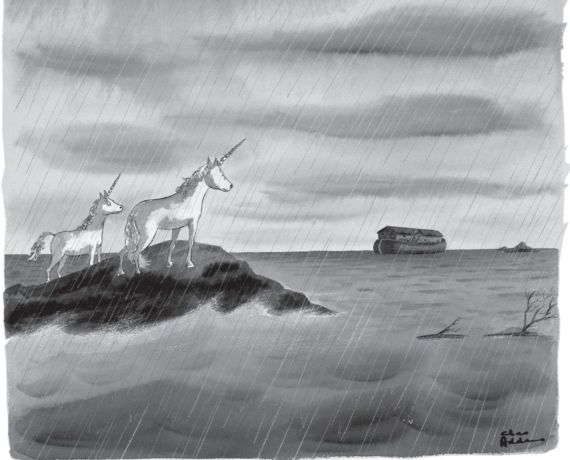
Cartoon by Charles Addams
“After forty days Noah opened the trap-door that he had made in the ark, and released a raven to see whether the water had subsided, but the bird continued flying to and fro until the water on the earth had dried up. ”
Genesis 8:6-7 New English Bible
Little is said about this raven [עֹרֵב – oreb], not even whether it ever returned. One suspects it didn’t. Ravens usually have their own agenda. The raven in question was almost certainly the Common Raven (Corvus corax), the same species we find today across North America and Eurasia. We’ll revisit ravens in general, and this citation in particular, in a later episode and move on to the more useful – to Noah, and to humanity by extension – dove.
“Noah waited for seven days, and then he released a dove (יוֹנִים – yonah) from the ark to see whether the water on the earth had subsided further. But the dove could find no place to settle, and so she came back to him in the ark, because there was water over the whole surface of the earth. Noah stretched out his hand, caught her and took her into the ark. He waited another seven days and again released the dove from the ark. She came back to him towards evening with a newly plucked olive leaf in her beak…He waited yet another seven days and released the dove, but she never came back.” Genesis 8:8-12 New English Bible
Why would Noah choose to send out a dove, of all birds, and what kind of dove was it? Ornithologists currently recognize 330 species of pigeons and doves grouped into 45 genera, so deciding which dove it was could be daunting. [All 330 species were presumably on the ark, along with the rest of the 10,000+ avian species.] Our story describes Noah’s ark as eventually coming to rest on Mt. Ararat, 16,945 feet high, 14,000-15,000 feet above the surrounding Armenian plain of eastern Turkey. We’ll assume the writer was an ordinary human who used his own experience to fill in details of his story; we’ll also assume that a bird noted was a bird familiar to the writer, and was then extant in the general region of the Middle East. In that region two dove or pigeon species predominate: the Rock Pigeon (Columba livia), also known as park pigeon, homing pigeon, or carrier pigeon, and the European (or Common) Turtle-Dove (Streptopelia turtur). Biblical Hebrew uses two words for these two species: tor (תֹּר), translated as dove or turtledove, and yonah (יוֹנִים), usually translated as pigeon, but sometimes as dove. Occasionally these words occur together, as when Leviticus 5:7 suggests using “two turtle doves or two young pigeons” as sin-offerings. Our cited passage states yonah, so Noah’s “dove” could be of either species.

European Turtle-Dove (Wikipedia)
Of the seventeen species in the Streptopelia genus, the European Turtle-Dove is the most widespread and common, found from the Azores Islands in the west, across northern Africa, Europe, the Mid-East and western Asia to Iran and far-western China. They are widely domesticated by humans, used as food and as caged companions. The “turtle” part of their name – as may also the Hebrew “tor” – refers to their cooing call, which sounds to human ears like the word “turtle.” This widespread impression is recognized in their name in many languages: French – Tourterelle des bois, Dutch – Tortelduif, German – Turteltaube, Swedish – Turturduva, and in the scientific species name, turtur. However, many people refer to this much-admired bird as simply “Turtle“, as did the British when the King James version of the bible was published in 1611. In recent years, and in regions which do not host turtle-doves, bible readers are often mystified by the following passage:
“For lo, the winter is past, the rain is over and gone; the flowers appear on the earth; the time of the singing of birds is come, and the voice of the turtle is heard in our land…” Song of Solomon 2:11-12 King James Version
Since when does one ever hear a turtle say anything? One doesn’t, and recent translations and updated versions have re-translated the Hebrew tor in this passage from “turtle” to “turtle-dove.”
Why send out a Dove? All pigeons and doves build nests of twigs. Not very well, I should add. They may be so loosely constructed that one can see the eggs through the bottom of the nest. After a mated pair locate a suitable nest site, frequently a fork in a tree limb, they (sometimes only one) fly off to find twigs to bring back; these may be dead and broken, but living twigs may be preferred for their flexibility. One of the pair may stay to guard the site and suitably arrange twigs brought by the other until the nest is complete. All pigeons and doves are strong and swift flyers, able to quickly cover a lot of area without needing to land. Many species can also find their way home through vast featureless areas.
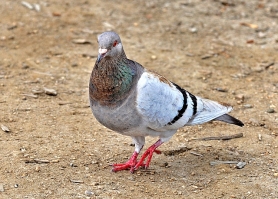
Rock Pigeon at Malibu Lagoon
(Jim Kenney 2-19-10)
The Rock Pigeon, whom the Israelites called yonah, has been domesticated for millennia for food, feathers, fun, and not least for its ability to reliably carry messages to its home roost from any distance or direction, despite adverse conditions of weather and light. Historians report that the use of “carrier pigeons” probably began in ancient Persia, and dates to at least 1000 BCE. Phoenician merchants at sea used the pigeon post to send messages home; the Greeks used them to announce results of the Olympic games. Such an instinctive “homing” pigeon, one who seeks and gathers twigs with which to build its nest, would be the perfect animal to recruit for the task of finding and returning living vegetable matter, to indicate the end of a flood and the reemergence of land and vegetation. It could fly for hours, cover a huge area, and reliably return, bringing a live twig if it could find one, or a dead twig if that’s all it could find. Genesis says (in translation) that Noah sent out a “dove,” but in all likelihood, it was not the European Turtle-Dove but the Rock Pigeon, whose biblical Hebrew name yonah, used in this passage, is translated as either pigeon or dove.

Rock Pigeons on cliff in Israel (Igor Svobodin)
The Rock Pigeon nests on barren cliffs, often in arid, confusingly-configured regions, and often had to travel wide and far to find food, water, and nesting material. This constellation of characteristics suggests that they may be the reason the species evolved such a remarkable homing ability.
The selection of the Rock Pigeon for this role in this story demonstrates that the writer was aware of four things: First, the mere fact of this species’ existence; Second, the bird’s ability to fly fast and far; Third, its natural desire to seek and

Peace dove with Olive Branch (Google)
bring back twigs for the purpose of nest-building; Fourth, its remarkable ability to recall the location of its home roost in the vastness of an unfamiliar and potentially featureless region. The earliest use of the Rock Pigeon as “carrier” pigeon is probably unrecorded, but here we see a suggestion that it was known, at the time of this story, in the Middle East. Because of this biblical passage, doves are now symbols of peace (or the forgiveness of an angry deity) and the olive branch is a symbolic peace-offering.
Linguistic confusion between pigeon and dove remains common today. There is no set rule as to which is which. Typically, larger birds are pigeons, smaller birds are doves. Each of the 45 genera in Columbiformes – with one exception – consists (in English) entirely of pigeons or entirely of doves, never a mixture. The sole exception is the genus Columba (which includes our Rock Pigeon) comprising 36 species, of which three are called “dove,” the rest are “pigeons.” The continuing drive for English avian nomenclatural consistency, including the goal of calling all species in the Columba genus by the name of “pigeon” brought, in 2003, the change from Rock Dove to Rock Pigeon. By it’s size it should be called a pigeon. All it’s closest relatives are called pigeons. The bible (except Noah) calls it a pigeon, park statues everywhere call it a pigeon, messenger services call it a pigeon. But speakers of English long branded it a dove, and, in biblical translation ever since, it has remained a dove.
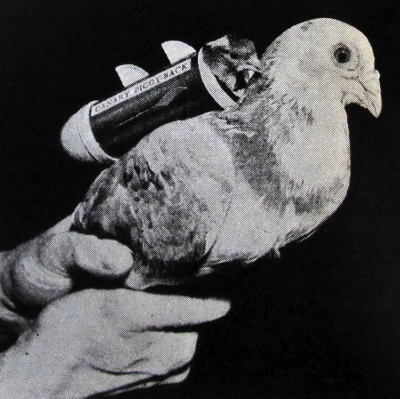
Carrier Pigeon carries a canary (WeirdUniverse)
The native range of Rock Pigeon is obscured by domestication. For millennia they have accompanied humans, and the descendants of escaped and released birds number into the many millions, if not billions, world-wide. They do not migrate. Their original range probably extended from the mountains of Morocco in the west to the eastern Indian Himalayas. They nest on ledges and in holes of rocky cliffs, hence the name Rock Pigeon. They have survived and spread exceedingly well throughout the modern world because humans have considerately constructed ledge-filled artificial cliffs for them, which we call buildings and bridges, and freely fed them sumptuous feasts, which we call trash.
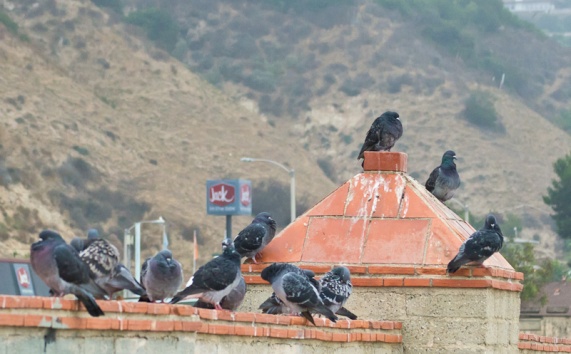
Rock Pigeons relaxing on man-made cliffs (Chuck Bragg 9-25-11)
Incidentally, Genesis 8:12 misrepresents this faithful and vigorous bird when saying it did not return to the ark. Very little will keep a Rock Pigeon from returning to its home roost. They do not often become lost. Only accidents, predation, or (unlikely) a new mate would keep it away from its home, its nest, and its mate. As all animals except our pigeon (or dove) were supposedly still parked on the ark at this time, there would be no predators or potential mates to keep it away. The disappearance of our pigeon is almost certainly a metaphor, a case of the biblical writer taking literary license to send a signal to the alert reader. After its scouring, the damp, new earth has received our pigeon – and all her living creatures by extension, including wayward humans – back into her fruitful arms.
Bible Factoid #1: Noah, the Flood, and the Epic of Gilgamesh
The biblical story of Noah and the flood is greatly predated by the flood story in the Epic of Gilgamesh. First discovered in Nineveh in 1853 and translated in 1870, the epic – considered by many scholars to be the first written work of literature in the world – dates to about 2100 BCE and relates the adventures of Gilgamesh, king of the city of Uruk in southeastern Mesopotamia. It was a popular story of that age
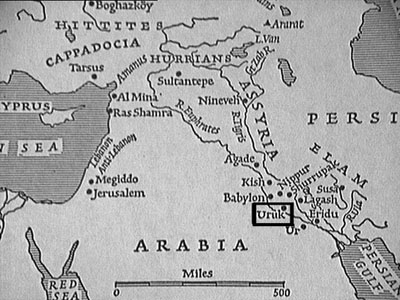
Mesopotamia & location of Uruk, city of Gilgamesh (nkerns.com)
and region, and parts of it have been found in excavations of other ancient cities. The description of the flood occurs near the epic’s end when Gilgamesh travels far to the northwest to find Utnapishtim, the then-immortal survivor of an ancient
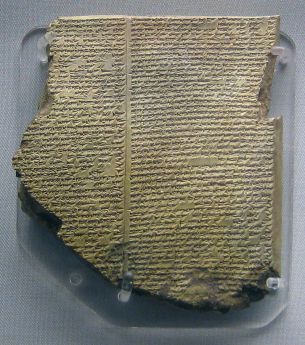
Deluge Tablet of the Gilgamesh Epic in Akkadian script (Wikipedia)
flood. In Utnapishtim’s narration, the rains lasted six days and nights; the boat then grounded on Mt. Nisir, a hatch was opened and the mountain could be seen; the boat rested for 6 days and nights; Utnapishtim then released a dove, which returned; a sparrow was released which also returned; a raven was released which found food, flew around and did not return. Utnapishtim then left the boat and made a sacrifice on the mountaintop. It is illuminating to compare these details to those found in Genesis 6-9.
This Gilgamesh story is now near-universally accepted by biblical scholars as the origin of the flood story found in Genesis. Before its complete translation in 1870, no one knew that the story of Noah’s flood was not original with Genesis, but was based on a far earlier story. [Chuck Almdale]
Additional Sources:
1. The Epic of Gilgamesh, translation and introduction by N.K. Sandars, 1964, Penguin Books, Baltimore. Pgs 7-16, 105-110.
2. New English Bible with the Apocrypha, The, Oxford Study Edition. Sandmel, Samuel, Suggs, M. Jack, Tkacik, Arnold J.; eds. (1972) Oxford University Press, New York
Return To Top
Sunday Morning Bible Bird Study II:
Sandgrouse or Quail?
This week’s topic comes from Exodus and Numbers, books two and four of the Pentateuch, when the Israelites, fearing starvation in the barren Sinai desert wastes, pine for the “fleshpots of Egypt,” and Yahweh promises to bring them manna and flesh to eat. [I’ll use Yahweh**, the commonly accepted name for the deity, as it’s the closest transliteration of the Hebrew YHVH, spelled without vowels (in English left-to-right sequence), written in these passages.]
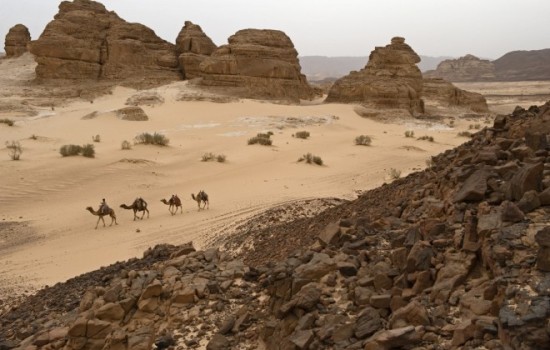
Climbing Mt. Sinai (Rough Guides)
The Lord [יְהוָ֖ה – Yahweh] spoke to Moses and said: “I have heard the complaints of the Israelites. Say to them, “Between dusk and dark you will have flesh to eat and in the morning bread in plenty.”.…That evening a flock of quails (שְׂלָו – selav) flew in and settled all over the camp…
Exod. 16.11-13 New English Bible
Then a wind from the Lord sprang up; it drove quails (שְׂלָו – selav) in from the west, and they were flying all round the camp for the distance of a day’s journey, three feet above the ground. The people were busy gathering quails all that day, all night, and all next day, and even the man who got least gathered ten homers. [10 homers = 890 gallons!] They spread them out to dry all about the camp. But the meat was scarcely between their teeth, and they had not so much as bitten it, when the Lord’s anger broke out against the people and he struck them with a deadly plague. Num. 11.31-33 New English Bible

Cartoon by Jeff Larson
The careful reader of these two passages, with their surrounding passages, will notice that in Exodus the quail and manna are simply sustenance as promised by Yahweh, whereas in Numbers, the quail are a punishment for the Israelite’s complaints about having only manna to eat; many of the people sicken and die from eating the quail. I’ll set aside this inconsistency for now and address our primary birder’s issues: what kind of birds are these, where did they come from, and what are they doing in the Sinai desert? Are numbers as enormous as described possible?

Sinai Peninsula satellite view from southeast (New World Encyclopedia)
Descriptions of birds given by non-birders are notoriously insufficient and inaccurate, as are what they think is the bird’s name. What birder has not been asked to identify a bird based on a verbal description which fits either hundreds of species (“It was dark and small…”), or no species at all? (“…with long legs and a green crest.”) One learns to be skeptical and to closely question in order to gather useful information. When I first read the above passages, the sandgrouse came immediately to mind. It’s not a quail, but an inexperienced, unconcerned or naked-eye observer might think it a quail, and binoculars were certainly lacking in the ancient Middle East.

Crowned Sandgrouse soaking their breast feathers
(HotspotBirding.com)
Sandgrouse are an interesting family of sixteen species, grouped into two genera. [Video] They are currently classified in their own order, Pterocliformes (notable wing), but they were previously placed in the order of Pigeons (Columbiformes) to whom they are remarkably similar. Sandgrouse habitats are typically described as “inhospitable,” “barren,” or “sere,” and includes wastes, plains, savanna and thorn scrub from western and southern Africa to India and Manchuria. [In a hot and unbelievably barren waste in South Africa, I once nearly stepped on a beautifully camouflaged sandgrouse, whom I did not see until it flushed from its nest and eggs, a foot from my feet.] Because they typically nest far from any water, they must swiftly fly (60 mph is common) long distances for water and carry it back to their nestlings. A unique adaptation enables them to do this: breast feathers which absorb water like a sponge and retain it well enough to allow their returning it to their young, who lap the moisture from their breast.
Birders know the most certain way to spot sandgrouse is to hide by a desert waterhole. Sandgrouse, usually in groups, visit waterholes in the morning and especially in the evening, first drinking, then wading into water to saturate their breast feathers, then flying back home. It seems that sandgrouse might be the answer to our question: they resemble a grouse (or quail), they live only in desert-like habitats, and they invariably come to waterholes in the evening.
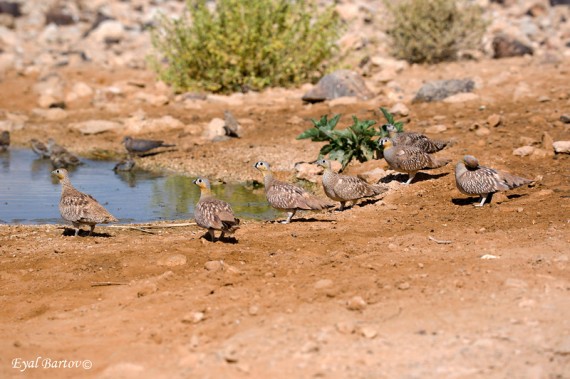
Crowned Sandgrouse flock at pool in Israel (Eyal Bartov)
There are three species currently living in the Sinai desert and adjacent regions: Spotted (Pterocles senegallus), Black-bellied (P. orientalis), and Crowned (P. coronatus); the Pin-tailed (P. alchata) Sandgrouse lives nearby in Arabia and Mesopotamia.
However, one problem remains. Because they are non-migratory permanent residents in their respective ranges (except for altitudinal migration of the Tibetan Sandgrouse), sandgrouse don’t congregate in large flocks as do many birds during migration, and their arid, barren homes can not support large resident concentrations of them. Perhaps sandgrouse is not the bird after all.
The Common Quail, Coturnix coturnix, (also called European or Eurasian Quail) has been very well-known for a very long time in the old world. Egyptian hieroglyphics from 5000 BC picture them. Their northern breeding range runs from western Morocco, throughout Europe to the Baltic States, across Russia and the Middle East to Lake Baikal and India. The western Eurasian breeders winter in Egypt and down the Nile River to Sub-Saharan Africa, while central Asian breeders winter in India. Some far-western birds migrate past Gibraltar, but most avoid that enormous barrier to European avian migration, the Mediterranean Sea, by flying around the east end: through Egypt, the Sinai, Israel, Jordan, Lebanon, Syria, Turkey and onward to Europe and western Asia. Northbound flocks can be in the hundreds; southbound groups are usually much smaller.
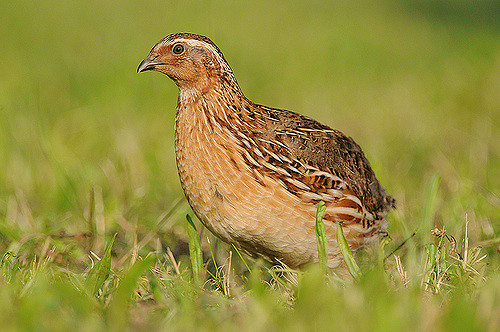
Common or European Quail (Ján Svetlík)
All other quail species are non-migratory residents and are poor flyers: fast and noisy on take-off but not adapted for sustained flight, and typically fly short and low. The Common Quail, adapted to migration, is longer-winged than other quail, and while able to fly swiftly, they also fly quite low, often nearly hugging the ground. Even today, many thousands of them are netted annually during migration in Sinai and other parts of Egypt; such annual netting used to number into the millions, but the population became dangerously reduced during 1970-1990.
Sinai net-hunting is like that elsewhere in Europe; nets are strung along valleys and mountain ridges where birds fly very close to the ground to conserve energy. It’s near-certain that for as long as humans have lived in this area, migrating Common Quail have provided a tasty and bountiful springtime repast. Flying, for quail, is thirsty work, and they try to find water before night falls, when they either go to roost or continue their migration in the dark. The mirror-like shine of desert water pools, visible for miles during daylight, become invisible ink blots at night, so stopping near sundown is best. Common Quail can and do migrate during the day and/or at night, but they also need to periodically stop, rest, drink and eat.

Common Quail netted at ground level in Gaza (Middle East Eye) [1]
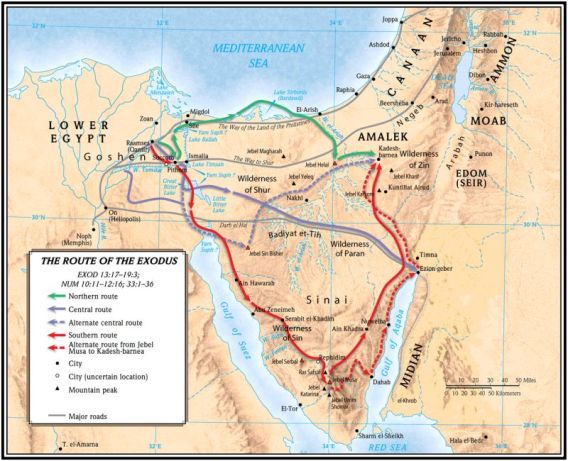
The solid red line (on this map) denotes their route from Egypt to Mount Sinai as presented in the Torah. According to the Torah, Mount Sinai can only be located at Jebel Musa, its traditionally accepted location. (All Faith.com)
Poisoned Quail?
The passage in Numbers 11.31-33 says that large numbers of people died almost immediately after eating the quail as a punishment for their greed. I can think of four possibilities to explain this. First, people who have not eaten meat for a long time can have a bad reaction to it. Second, sun-dried quail flesh may not be free of contamination. Third, birds, like people, can build up high levels of metabolites in their muscles during periods of sustained exertion. (Lactic acid buildup during anaerobic exercise creates that “burn” in your muscles.) Perhaps such metabolites could poison hungry, involuntary vegetarians who greedily gobble down their food (possibly sun-dried or insufficiently cooked). Fourth, many people today believe that quail migrating around the east end of the Mediterranean can accumulate toxins by eating hemlock or other poisonous plants. The term coternism (from Coturnix for “quail”) describes those who have been poisoned from eating quail. Aristotle, Philo, Galen and other ancients commented on such quail poisoning.
It has been reported that Common Quail are poisonous only during migration, and only those that fly around the eastern end of the Mediterranean; not those following other routes or while on their breeding or wintering grounds. Various food plants have been blamed: hellbore, henbane, hemlock, woundwart. Whatever the toxin, it appears to be stable, as cases have been reported of people poisoned by four-month-old pickled quail, and by potatoes fried in quail fat. Some quail eaters practicing such “dietary roulette” needed to have their stomachs pumped.
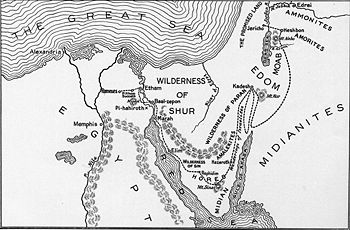
Probable Midian territories during Exodus era
(New World Encyclopedia)
In Exodus 2-4, Moses is described as fleeing Egypt to live for years in the “land of Midian,”, where he married Zipporah, the daughter of Jethro, a Midian priest, and spent time minding Jethro’s flocks of sheep, a task which took him into the wilderness, including the vicinity of Mt. Horeb. Such an occupation would quickly teach anyone how to find water and food both for himself and his sheep, and Moses would have become quite familiar with local water holes and the periodic passage of flocks of quail, knowledge that would come in handy if one found themselves leading a crowd of foreigners through this region. An experienced leader might plan ahead and specifically choose quail-migration-season as the preferred time to escort travelers.
As usual, biblical scholars cannot agree on the location of “Midian,” “Mt. Horeb,” “Mt. Sinai,” whether Mt. Horeb is also Mt. Sinai or not, or if the mountain has two peaks – one called Sinai, the other Horeb – the route of the Exodus, the number of people, the length of time, and just about every other detail in this entire story.
But whether these events in Exodus and Numbers actually occurred as described is, frankly, irrelevant for the purposes of this essay. We’re simply looking at what birds are mentioned, and what was written about them. The facts pertaining to Common Quail behavior as described in these passages (exaggerations excepted), actually did, and still do, occur. The events could have happened to anyone traveling through the Sinai Peninsula during quail migration season(s), and the mere fact that the description was written down in Exodus (whenever and by whomever it was written), means that they had previously occurred to some people, and were probably common knowledge to local residents. Such local knowledge concerning water and food would be essential to merchants, caravan leaders, shepherds, and anyone else traveling through such a difficult and barren region.
** Bible Factoid #2: YHVH [יְהוָ֖ה] [Yahweh]: When Moses asks – in Exodus 3:13-14 – the deity for his name so he can tell the Israelites who is sending him, YHVH (letters = yod-he-waw-he) is the answer. This is usually translated as “I AM.” The longer passage is “YHVH [I AM]; that is who I am. Tell them that I AM has sent you to them.” The Hebrew form YHVH is actually third person – “He is” – but as the deity is depicted as explaining his own name in the first person, the explanation becomes “I am.” [New English Bible, footnote Ex. 3:12] This explanation is expanded in Ex. 3:14-15 to “I will be what I will be.” Since this was written, scholars and theologians have argued long and hard about this name, its meaning(s) and implications. It should be noted that “I AM” – in numerous languages – is widely used in Hindu and Buddhist religions as a mantra and an object of meditation; many consider it to be the briefest, truest expression of the mystical presence of the deity – or nirvana – within each human consciousness. As such, it is also being examined in the recently developing field of Neurotheology.
Note: The link to an article on Grouse netting in Gaza is placed below, rather than embedded in the text, because I decided to not leave our website permanently linked to that site. [Chuck Almdale]
[1] middleeasteye . net/in-depth/features/common-quail-feeds-poor-gaza-594657522
Additional Sources:
1. Handbook of Birds of the World (HBW), Vol. 4. del Hoyo, J., Elliott, A. & Sargatal, J. eds. (1997) Lynx Edicions, Barcelona. Pg 55.
2. HBW Vol. 2. (1994) Pg. 509
3. New English Bible with the Apocrypha, Oxford Study Edition (NEB), Sandmel, Samuel General Editor, (1976) Oxford University Press, New York.
4. Birds of Europe. Mullarney, K., Svensson, L., Zetterström, D., Grant, P.J. (1999) Princeton University Press, Princeton, N.J.
Return To Top
Sunday Morning Bible Bird Study III:
Junglefowl in Judea?
Flood-pigeons, desert-quail – what could be next? Our topic this week is arguably the second most famous bird in the bible, following the pigeon and his Noah. We speak, of course, of the chicken, or more specifically, the male of the species, the cock.
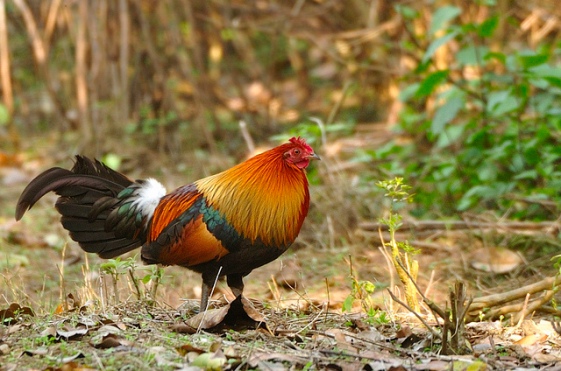
Cock Red Junglefowl in all his glory, Corbett Nat. Park. northeast India (Rahul Pratti)
Peter replied, ‘Everyone else may fall away on your account, but I never will.’ Jesus said to him, ‘I tell you, tonight before the cock crows you will disown me three times.’ Matt. 26:33-34 New English Bible
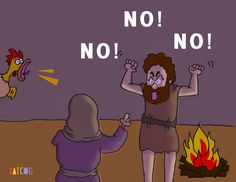
Methinks the man doth protest too much. (Tatcog School)
Shortly afterwards the bystanders came up and said to Peter, ‘Surely you are another of them; your accent gives you away!’ At this he broke into curses and declared with an oath: ‘I do not know the man.’ At that moment a cock (ἀλέκτωρ – alektor) crew; and Peter remembered how Jesus had said, ‘Before the cock crows you will disown me three times.’ He went outside, and wept bitterly. Matt. 26.73-75 New English Bible
The third time is the charm, as they say. All Christians ought to know of this story, as will many non-Christians. Who cannot feel both pity for poor Simon “Peter” (Πέτρος – Petros: Greek** for rock), and embarrassed empathy with him in his cowardice and fear. How many of us would be courageous and foolish enough to declare faith and allegiance to Jesus, when he’d just been hauled off, probably to be executed, along with any followers who didn’t slip away.
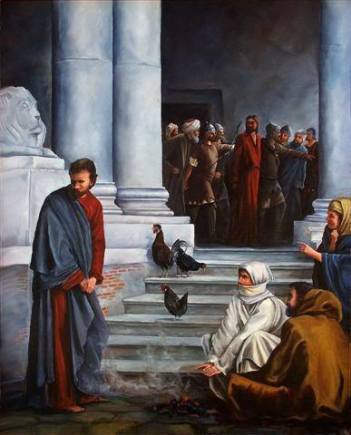
Peter, the rooster and Jesus; Copy of painting by Carl Heinrich Bloch 1834-90 (RonCarol205)
The story tells us that Jesus – well aware of Simon’s rash and boastful tendencies – told him that despite his protestations of faithfulness unto death, Simon wouldn’t even make it until the next dawn before “chickening out” three times. Yet, Jesus forgives Simon his weakness in advance.
This is one of the few tales found in all four Gospels. After the troops arrest Jesus, Simon follows them to see what will happen. Perhaps he will rescue Jesus! In three versions, Simon is alone; in John 18:15 he is accompanied by another disciple. He (or they), end up at the High Priest’s house, where he mingled with others in the courtyard around a fire, trying to stay warm, (see picture above) yet still keep a low profile. But his northerner’s accent gave him away as one of the Galilean followers of Jesus.
Mark 14:72 has the cock crowing twice; the other three passages agree on once. But we’ll now leave Simon and Jesus to follow our own trail, which is to examine the third actor in this play, that crowing rooster, and see how he got to first century Judea and why he was crowing.
Anyone who has ever slept near a farmyard, anywhere around the world, knows that roosters (or cocks, as the male of the chicken and allied species are called, as in Peacock), call at dawn, waking us up whether we want to or not. Actually, nearly all birds with any kind of voice and who maintain personal territories, call around dawn during their breeding season, largely to let their avian neighbors know that they lived through the night and they’d better stay out of his territory. Most aren’t as loud as the rooster, for whom it seems to be always breeding season.
Travelers to the tropics are often enchanted by the rainforest “dawn chorus’. Birds begin murmuring their nearly inaudible ‘whisper songs’ around first light, as if still groggy, get really loud around dawn, and dwindle away by ½ – 1 hour after dawn, when it’s light enough for them to begin finding their first meal of the day. In fact this happens everywhere; but it’s more noticeable when 500 species of birds sing within a mile of your bed. Cocks are no exception; his territory may consist of only a few bare square feet of ground, but it’s his and he will fight to the death to protect it and his mating rights with any hens therein. In Muslim countries, cocks first crow at first light, when the Muezzin first calls the faithful to prayer, when the still-unseen sun tints, however slightly, the eastern sky.
About one-third of the 174 members of the Phasianidae (Pheasant & Partridge family) are non-monogamous, including the Red Junglefowl (Gallus gallus), the official English name for our chicken species. Red Junglefowl are very sexually dimorphic, and the male has larger tail and fleshy comb, with overall brighter and more colorful plumage. The male maintains his territory by crowing and fighting with male intruders, using his bony spurs as weapons, and he gathers as many females as he can. Crowing, especially at dawn, is essential to his survival, to fulfill his evolutionary imperative to get his genes into the next generation as often and as successfully as possible. Within his territory, the rooster “rules the roost.”
According to the Oxford English Dictionary, the English name “cock” for the male chicken is from “kokke” in Old English, “coq” in 12th century French, and kokkr in Old Norse. All these names are likely echoic, imitative of its voice, as in “cock-a-doodle-doo.” The name “rooster” comes from “one who roosts;” both males and females of many Phasianidae species spend the night safely roosting on tree limbs.
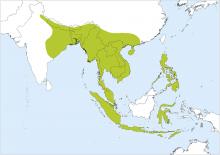
Home range of Red Junglefowl
(Handbook of Birds of the World)
All domesticated animals originated somewhere; they haven’t always lived in our backyards. Cattle originated in Europe, where wild cattle are long extinct; Ring-necked Pheasants ranged from western Georgia, east of the Black Sea, to east China; Guinea Pigs began in Peru, where they were a favorite food of the Incas. Red Junglefowl originated in Southeast Asia, where they still range from Nepal and central India eastward through Burma, Vietnam, and Malaysia to the Indonesian Lesser Sunda Islands. Their traditional range likely stopped at Bali, just west of the Wallace Line dividing Asian fauna from Austronesian fauna, but they now live throughout Sulawesi and the Philippines

Wallace Line – Bali is eastern end of Red Junglefowl range, excluding introductions by humans. (Wikimedia)
where they were introduced millennia ago. Their official English name, Red Junglefowl, comes from their original color and preferred habitat. Even now, they regally stalk silently through the forest undergrowth, scratching the soil for seeds, grubs, and grit, leading their precocial chicks on their daily search for food. It is a wonderful thing to hear the dawn territorial call of a cock Red Junglefowl in the dripping ink-black rainforest of Malaysia, and know that this bird has escaped the doom befallen so many of his brethren. It’s even more wonderful to see them; both sexes are beautiful, magnificently plumaged birds. This pair, at least, will never suffer that most humiliating of all fates, to become a McNugget.
According to recent genetic studies, the clade of Red Junglefowl living at the western end of their range, in India, are the ancestors of all domestic chickens now found throughout the New World, Europe and the Middle East.

Location of chicken fossils, Yellow River area, China (Daily Mail)
In northern China, fossilized Chicken bones dating back 10,500 years were recently discovered in the Yellow River area, which DNA analysis determined to be Gallus gallus. This area is well outside the known historical range of the species and they are likely the oldest examples of domesticated chickens in the world. It is thought that the ancestors of this group were from southeast Asia – Vietnam for example – rather than from the Indian clade.
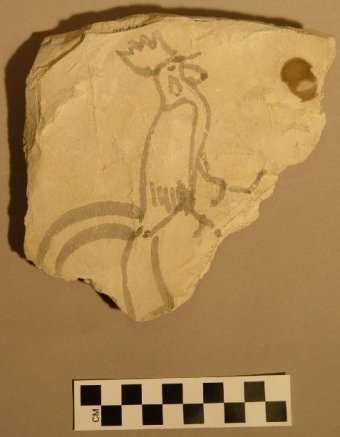
Ostracon of rooster c.1500 BCE, discovered by Howard Carter, 1923, while searching for King Tut’s tomb. (British Museum)
An ostracon (inscription on potsherd) from fifteenth century BCE Egypt depicts a cock. The Annals of Thutmose III (1558-1538 BCE), describing his battles in Babylonia, mentions bringing back to Egypt the “bird that gives birth every day.” By the fifth century BCE they appeared in Lydia (Western Turkey) and Greece.
A Greek legend tells us that western civilization was saved by chickens! In 480 BCE, Athenian general Themistocles, leading his troops to fight Persian invaders stopped to watch two cocks fighting by the side of the road. He gathered his men to watch and said, “Behold, these do not fight for their household gods, for the monuments of their ancestors, for glory, for liberty or the safety of their children, but only because one will not give way to the other.” The soldiers took heart from this – perhaps they didn’t want to seem less courageous than chickens – and marched on to defeat the Persians, thereby saving Athens, Greece, Democracy and Western Civilization. Score one for the chickens, the very models of bravery.
Nowadays, chickens are found by the billions wherever humans live. We are surrounded by these fowl in so-called egg or chicken “factories,” living lives that make our lives of quiet desperation (as Thoreau said) seem in comparison like ecstasy in paradise. We have thoroughly, remorselessly, and unremittingly domesticated them, but it wasn’t always so.
Chickens then, as now, were common trade goods between peoples. These useful and easily maintained animals produce eggs, feathers and flesh; they’re great predators of annoying pests in your garden; the males, equipped with sharp spurs on the back of their feet, are the central attraction of one of the world’s oldest blood “sports” and gambling attractions. Such an animal would spread rapidly among all people who encountered them. Evidence suggests that the residents of Harappa in the Indus Valley not only had chickens, but they traded with the Middle East. Directly or indirectly, chickens were traded hand to hand, village to village, tribe to tribe, nation to nation, until they made their way to Persia, Syria, Egypt, Lydia, Greece and Judea, where they were common as dirt long before the birth of Jesus. Jesus and Simon may have walked from the Galilee to Jerusalem, but that rooster and his ancestors came a whole lot farther. They were so common in Judea that they were hardly worth mentioning, and wouldn’t have been, if first century Jews couldn’t reliably count on them as heralds of the coming dawn, when the new sun shines upon us all.
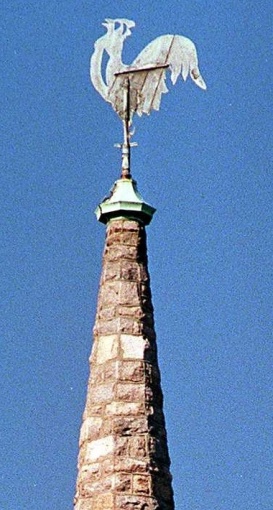
Rooster on top of First Presbyterian Church, Wilmington, NC (MyReporter)
There is one – and only one – additional mention of chickens in the entire bible.
“O, Jerusalem, Jerusalem the city that murders the prophets and stones the messengers sent to her! How often have I longed to gather your children, as a hen (ὄρνις – ornis) gathers her brood under her wings, but you would not let me.” Matthew 23:37
Had this image caught on, rather than that of the good shepherd with his lambs, it might have completely changed the course of Christian iconography. Imagine, if you can, Jesus as the “Hen of God,” and all people as his chicks.
But chickens weren’t completely overlooked by the new religion. Pope Nicholas I (858-867 CE) decreed that a figure of a rooster should be placed atop every church as a reminder of our story—which is why many churches still have rooster-shaped weather vanes.
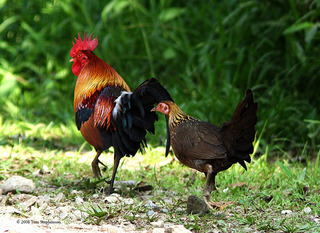
Red Junglefowl pair in forest, where they belong.
(DiscoverLife – Tom Stephenson)
I’ll leave you with one final thought. People today often assume that commerce of goods and ideas between the Orient and the Occident was nearly nonexistent in ancient days. But we now see that chickens, tangible, living animals subject to loss, escape and death, were transported by humans through forests, deserts and rugged mountains, at least 2500 miles by land, well before the time of Jesus. What about intangible things? Our so-called “Arabic numerals” originated in India, where Persians discovered them and popularized them in the Middle East around 825 CE. We know that chickens preceded Arabic numerals by 2300 years. Might not ideas, ethics, philosophies, religious values and theological tenets have made their way back and forth even more easily? Perhaps the origins of the religions and philosophies of the Mediterranean and Middle East – the philosophy of Greece, the polytheism of Egypt, Greece, and Rome, the monotheism of Jews, Christians and Muslims – are not so local and insular as they appear on first glance.
For much more on the history of Red Junglefowl: Smithsonian – How the Chicken Conquered the World
And…just to shake the ground beneath our feet, here’s another view which posits that the cock in our story was not a bird at all, but a horn!
**Bible Factoid #3 – New Testament Greek
You may have noticed that we are now translating from Greek, not Hebrew. The New Testament was written in Greek – not Hebrew, Aramaic, Latin and definitely not the English of the King James Version (1611). The language was not classical Greek, but Koine (street, common or vulgar) Greek. Koine, also called Hellenistic Greek, developed from the various classical Greek dialects and was the main spoken form from the time of Alexander the Great (died 323 BCE) until about the time of Tiberius II Constantine, circa 580 CE. New Testament Koine Greek was filled with local semiticisms, not used elsewhere in the Greek-speaking world. [Imagine if the King James Version had been written in modern Jamaican patois rather than Elizabethan English.]
After Alexander’s conquest, the Middle East was ruled by Greeks (Hellenistic Period) until the Romans conquered the Middle-Eastern empire of the Seleucids in 63 BCE. Greek was the dominant cultural language, so much so that the Jewish Scriptures (the Christian Old Testament) were translated from the original Hebrew into Koine Greek, beginning in the third century BCE and finished in 132 BCE. This translation, called the Septuagint (frequently abbreviated LXX) for the 70 (or 72) scholars reportedly involved in the translation, is believed to have been commissioned by Egyptian King Ptolemy II Philadelphus and intended for the Library at Alexandria. In 1st century CE Judea, Hebrew was still spoken alongside Greek and Aramaic. Aramaic was dominant in Galilee and was probably spoken by Jesus and his followers. A few of the words of Jesus quoted in the Gospels are in Aramaic – abba (familiar form of father – “papa”) and ephphatha (“be opened”) for example. [Chuck Almdale]
References not linked above
Handbook of Birds of the World (HBW), Vol. 2. del Hoyo, J., Elliott, A. & Sargatal, J. eds. (1994) Lynx Edicions, Barcelona. Pgs 452, 529-30.
New English Bible with the Apocrypha, The, Oxford Study Edition. Sandmel, Samuel, Suggs, M. Jack, Tkacik, Arnold J.; eds. (1972) Oxford University Press, New York
Oxford Companion to the Bible. Metzger, Bruce M. & Coogan, Michael D. eds. (1993) Oxford University Press, New York.
Additional Reading
How the Chicken Conquered the World. Adler, Jerry & Lawler, Andrew. Smithsonian Magazine, June 2012.
Return To Top
Sunday Morning Bible Bird Study IV:
Birds that Sow, Reap and Store
This week’s topic is not a particular bird, but stems from a general comment about birds. This well-known and oft-quoted verse appears near the end of Jesus’ sermon on the mount, a long oration in which he offers the mass of listeners advice for living a better life.
‘Therefore I bid you put away anxious thoughts about food and drink to keep you alive, and clothes to cover your body. Surely life is more than food, the body more than clothes. Look at the birds (πετεινὰ – peteina, plural of bird) of the air; they do not sow and reap and store in barns, yet your heavenly Father feeds them. You are worth more than the birds! Is there a man of you who by anxious thought can add a foot to his height?’
Matt. 6:25-27 New English Bible
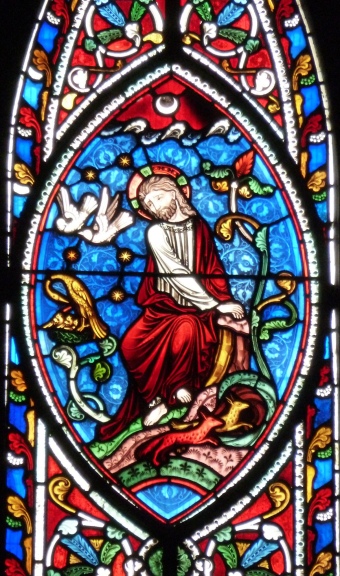
Stained glass of Jesus, birds and foxes
(Glass Angel)
Put into a modern context, we are being told that if we let go of our never-ending fears, we’ll fuss and fret less and be happier. Endless anxiety does not make us taller or live longer. Birds do fine without such needless fretting. We are greater than they; we can live better that we do.
The bible is full of poetic and literary devices: similes, metaphors, rhyme schemes, and repetition for emphasis are only a few. However, there are many people who interpret literally passages such as the above and who, knowing little about birds or other animals, might think they actually lead lives of perpetual ease and frolic. As with humans, birds have their own agendas; entertaining humans is very low on their list. Their lives are filled with peril; they need all their courage, wits, and a lot of luck to survive long enough to raise young of their own. 80-90% of all birds die in their first year.
To illustrate some of the survival strategies birds use, I’ve selected three species which anyone in Southern California can see without much difficulty.
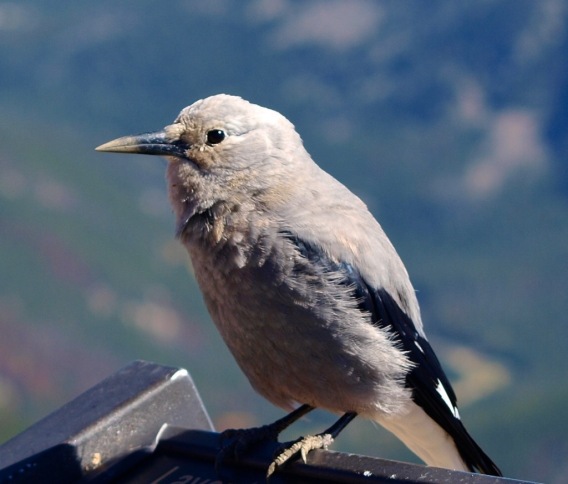
Clark’s Nutcracker, Aspendell, Inyo Co, CA (Joyce Waterman)
High in the mountains of western America, including our local San Gabriel Mountains, lives the Clark’s Nutcracker. Discovered by William Clark of the Lewis and Clark Expedition near the north fork of the Salmon River (near modern-day Kamiah, Idaho) on August 22, 1805, they were later named for him.
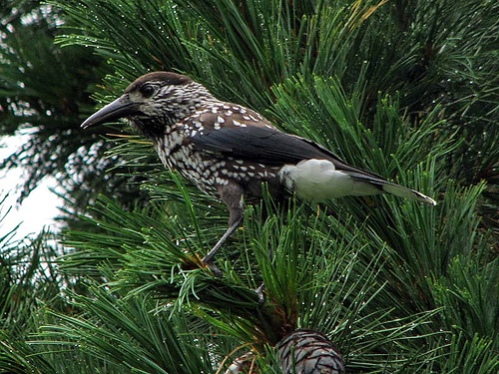
Eurasian Nutcracker, Manzushir Khiid, Mongolia
(Dreaming of Danzan Ravjaa, January 2009)
The family Corvidae (Crows and allies) has 125 species, grouped into 25 genera. The three nutcracker species are in the Nucifraga genus: Eurasian (previously Spotted) N. caryocatactes, Kashmir N. multipunctata, and Clark’s N. columbiana. Kashmir Nutcracker is restricted to Pakistan and northwest India;
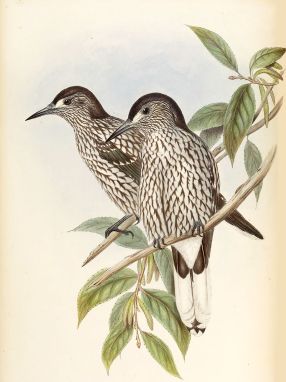
Kashmir Nutcracker
(painting by John Gould, 1849)
Eurasian ranges widely from central Europe to the eastern Himalayas and far eastern Siberia, getting no closer to Judea than northern Greece; Clark’s ranges across western U.S. and Canada, from northern Baja to British Columbia and down the Rocky Mountains to New Mexico. All three species live on conifer-covered alpine slopes, ranging between 3500 ft. and tree line, usually between 10,000 and 12,000 ft.
A close relative of crows and jays, Clark’s Nutcracker is twelve inches long, a bit larger and stouter than our local California Scrub-Jay. It does not migrate, but remains resident in its alpine coniferous habitat throughout the windy, bitter cold of the mountain winters, occasionally descending to lower slopes. Trees and shrubs provide no food for it at that season, yet it survives, despite winter’s high energy demands. How it does this is quite amazing.
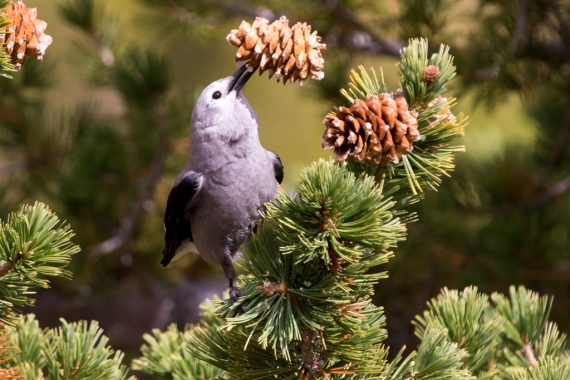
Clark’s Nutcracker pulls a nut (Greg Bergquist, 10-15-04)
The Clark’s Nutcracker survives the winter primarily by eating pine nuts. The nuts, however, are not on the cones which may have blown away in the high velocity winds, but are safely stored in the ground. Like squirrels, nutcrackers spend the autumn extracting pine nuts from cones. Their long, pointed and stout bill is perfect for hammering on cones and plucking out nuts. But they don’t store the nuts in a few large close-at-hand caches like the squirrel. What they do is far more interesting and ecologically beneficial.
The nutcracker packs a mass of seeds into its sublingual (below the tongue) pouch and carries them, as much as ten miles, to its storage area in deep woods or on a windswept ridge. There, where the coming winter’s snow will lie less deep, it makes a hole in the soil with its sharp bill, pushes in one or more seeds, and covers the hole with soil or ground litter. More holes are made for the other seeds. Then it flies back to the ripe-seed ground to repeat the whole process. Individual nutcrackers may store 100,000 seeds in a single season, creating many tens of thousands of holes. And it remembers where the holes are. In natural and experimental situations, nutcrackers have recovered 50 to 99 percent of stored seeds. Experiments show that they remember each hole’s positions relative to local landmarks such as trees and rocks. If such landmarks are moved, say by a meddling scientist, the bird seeks for holes where they ought to be (relative to the moved landmarks) but are no longer.
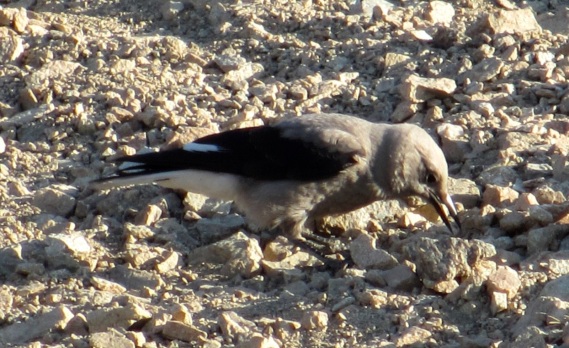
Clark’s Nutcracker caching nuts, Mt. Baldy, CA (“Bob” – July 2013)
Choosing areas for storage where snow will lie less deep ensures easier retrieval of the seeds. Pine nuts are nutritious, loaded with energy-packed oil, and can sustain the birds through winter. But no nutcracker retrieves all their nuts. Some remain in the ground, sprout, and grow into new trees. Windswept, barren slopes provide young trees with more sunlight and less competition from mature trees. Thus the forest is replenished.
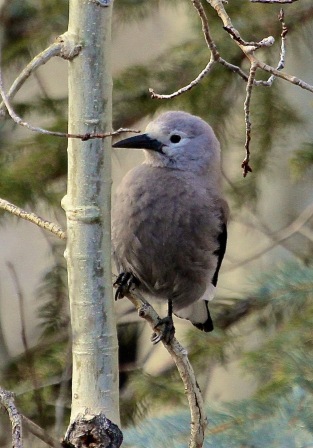
Juvenile Clark’s Nutcracker, Colorado (Joyce Waterman)
Studies have shown that the vast coniferous forests of (pre-European occupied) western North America were created largely through the activities of squirrels, nutcrackers and several of their Jay relatives. Heavy cones and nuts do not travel far without animal transport, and nuts in unopened cones frequently fail to germinate. The trees feed the squirrels and birds, and they in turn enable the forests to spread. In a sense the nutcrackers are “sowing” the forests; this shelter and food is reaped by itself and later generations of nutcrackers.
So, when considering the Clark’s Nutcracker, we must agree that they sow the coniferous forest, reap the nuts and have their own personal “barns” of which they memorize every nook and cranny! Think about that the next time you can’t find your car keys.
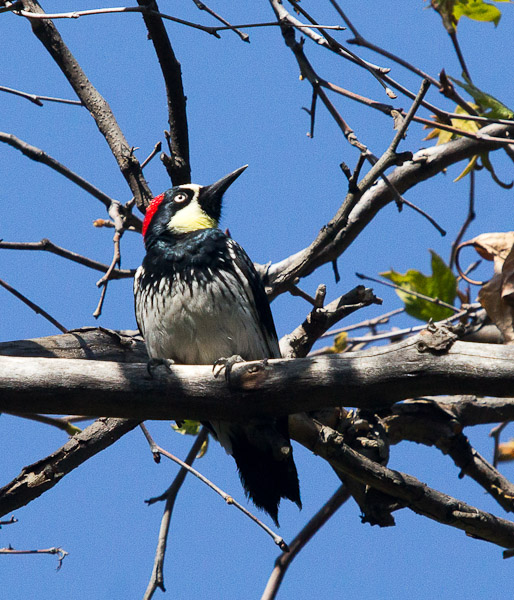
An alert female Acorn Woodpecker. Placerita Canyon State Park
(Chuck Bragg 4-7-12)
The Acorn Woodpecker (Melanerpes formicivorus) ranges from southern Washington State down to the western slope of the Colombian Andes Mountains. Except for the southern populations in Central and South America, they have the unusual behavior of collecting tens of thousands of acorns and storing them in granary trees. The granary is not a large cavity containing many nuts, instead it is one – sometimes more – entire tree with tens of thousands of small holes drilled by the woodpeckers into the trunk and large limbs. Each hole takes one-third to one

Acorn Caps. Malibu Creek State Park
(Chuck Almdale 4-12-14)
woodpecker-hours to drill, and into each hole one acorn, still in its shell, is pounded. The woodpeckers gather the acorns in the fall, when they’re ripe, and store them in their granary. Throughout the winter the nuts are extracted, as needed, to feed the colony. The acorns fit tightly and are very difficult for other birds and squirrels to steal them; anyone trying will be discovered and driven off by the granary owners. A granary tree can look like Swiss cheese. Telephone poles have collapsed after years of use as a granary.
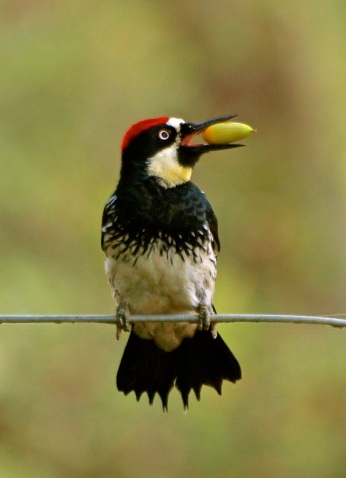
Male Acorn Woodpecker with acorn, CA
(Joyce Waterman)
A granary of 50,000 holes will take 15,000 – 50,000 hours to create – far too much time for a single bird or mated pair to create. These are multi-generational projects, begun by a single pair of birds, and continued from one generation to the next. Because acorn shells shrink while stored, they become loose in their holes and must be moved to a new hole, so new holes are constantly added. In order to create and maintain such a huge project, Acorn Woodpeckers developed several unusual breeding strategies, one of which is called helpers-at-the-nest.
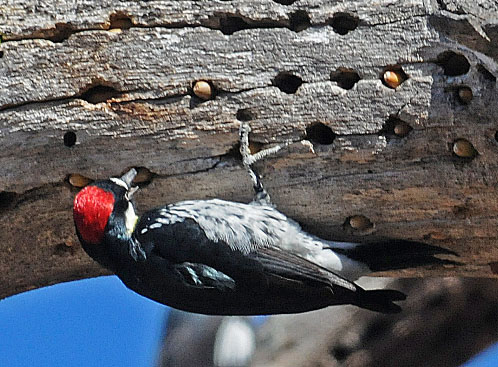
Acorn Woodpecker at her granary. Malibu Creek State Park
(Jim Kenney 11-10-12)
Unlike most species of birds, young Acorn Woodpeckers often do not leave their parents to find a mate, build their own nest and start their own families. This species does not migrate to find warmer climes and abundant food in winter. They are resident and stay in their territory throughout the winter. A well-stocked granary enables them to survive the winter but, conversely, it is very difficult for a resident pair to survive the winter without a well-stocked granary. The best way for an Acorn Woodpecker to survive and propagate is to inherit the family granary. So the young of previous years may stick around for many years, helping their parents to feed and protect this year’s crop of nestlings. This enables them to “learn the ropes,”, and be ready to take over the nest holes and granary when the parents eventually die.
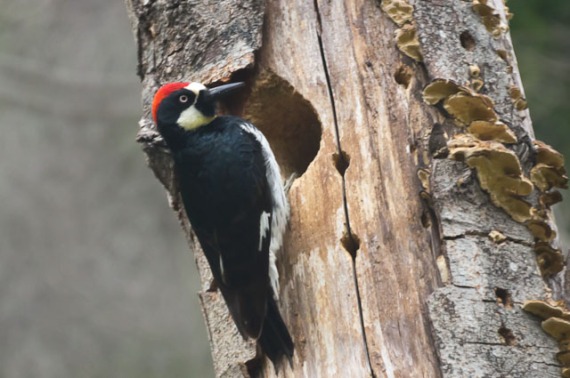
Male Acorn Woodpecker at the nest-hole. Solstice Canyon State Park
(Chuck Bragg 5-7-11)
Colonies can begin nesting earlier in the season when they have stored acorns. Studies have shown that colonies with a granary have larger clutches and fledge up to five times more young than colonies or pairs without granaries. Acorn Woodpeckers are great flycatchers, and during the breeding months, the chicks are fed insects, supplemented by fruit and granary acorns. As with humans, inheriting the “family farm” is a tremendous advantage. But not all breeding-age birds can wait that long.
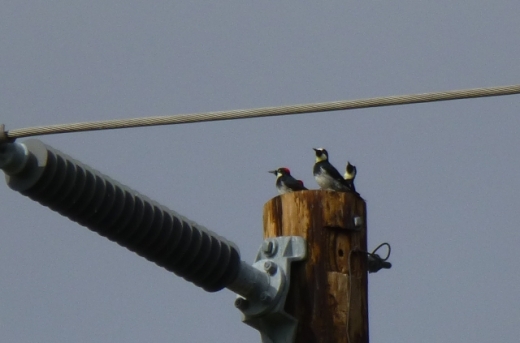
Acorn Woodpecker trio. Malibu Creek State Park, Reagan Ranch section
(Chuck Almdale 4-12-14)
Young female helpers often lay eggs in their mother’s nest. While the dominant female is good at preventing non-family birds from “dumping” eggs into her nest, she is unable to stop her own children from doing so, and cannot pick out and eject eggs not her own. So the helpers have a second reason to hang around. Colonies may even have multiple nest holes and multiple pairs of related birds simultaneously nesting.
Acorn woodpeckers don’t “sow” but they reap and they most definitely store their crop. Their complex and variable breeding strategies have evolved around their dependence on their granaries.
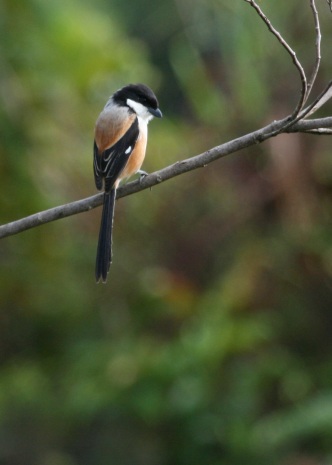
Long-tailed Shrike ready to swoop down on prey. Ambua Lodge, Papua New Guinea highlands (Chuck Almdale, August 2008)
Not all food stored by birds consists of nuts and grain. Shrikes store meat. The Shrike family Laniidae, distributed worldwide excepting Australia and South America, has thirty-two species. All feed primarily with a sit-and-wait method: perch upright on a bare twig or post or wire watching for movement, fly out to capture the prey, bring it back to eat it or store it in the “larder.” Prey can be large insects and small birds, reptiles or mammals, but they are known to kill prey 3-5 times as large as their own body mass. Two examples from Southern Grey Shrike larders: In India, one contained a 10-inch saw-scaled viper; in Israel, another held both a fat Sand Rat and a dead Southern Grey Shrike, an unwary intruder.

Great Grey Shrike and his impaled mouse.
(Aves et ales Animales 6-Mar-2015)
Their larder consists of thorns, sharp twigs or barbed wire, upon which they impale their dead prey; busy shrike may have many corpses thus impaled, for which habit they are also colloquially called “butcher birds.”
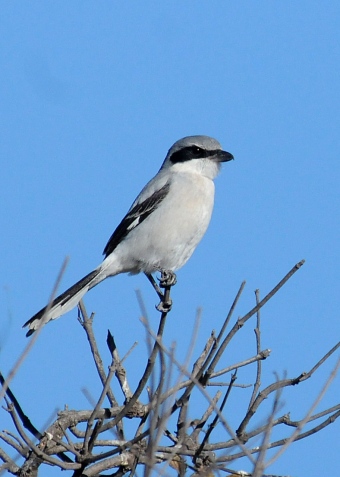
Loggerhead Shrike sits-and-waits on his bare twig perch. Malibu Creek State Park
(Jim Kenney 11-20-12)
Our local Loggerhead Shrike (Lanius Ludovicianus) is a 12-inch long passerine, looking much like a Mockingbird but with a thicker, hooked black bill. Lacking the talons of a true raptor, it kills its prey by crushing it in its bill or bashing it to death. They have figured out how to eat poisonous Monarch Butterflies: impale them on a thorn for up to three days until the poison breaks down. Shrikes, endemic to North America, have recently suffered an enormous population decline of 76% between 1966 and 2015, primarily due to eating pesticide-laden prey, it is suspected.
Clark’s Nutcracker, Acorn Woodpecker and Loggerhead Shrike – three local examples of the world’s hundreds, if not thousands, of examples of birds that sow or reap or store their food.
Bible Factoid #4 – Whence Jesus? (Ἰησοῦς –Ihsous)
Since we just finished nitpicking one of Jesus’ sayings, let’s take a look at the name itself. In modern America, many people pronounce it “Geezuz,” which would have been unrecognizable to Jesus’ family and friends. We’ll work backwards to see how it got this way.
The hard “J” that sounds like “G” (as in George) became permanently affixed to “Jesus” in 1611 CE by the King James Version of the bible, by which time the letter “J” had finally entered English. Since the Norman Conquest in 1066, the hard “J” had slowly evolved out of the much softer “IA,” primarily because people thought the hardness sounded more masculine: Iames became James, Ian and Iain became John (except in Scotland), Iestin became Justin, Ieremias became Jeremiah, and Iesus (ee-ay-soos) became Jesus (Gee-sus).
The 1384 CE translation by John Wycliffe from the Latin Vulgate bible into English had retained the earlier Latin “Iesus” (“ee-ay-soos”), which dated back to 382 CE, when Jerome completed the translation of the bible from Koine Greek into common (or “vulgar”) Latin. The Vulgate codified “Iesus” in Latin as the transliteration of Ἰησοῦς (Ihsous, pronounced “ee-ay-soos”) from the Koine Greek of the original New Testament books.
Koine Greek was the written language of the New Testament, but was not the only language spoken in first century Judea – Hebrew, Aramaic and Latin were also spoken; Aramaic was the predominant language around Galilee, whence came Jesus, the man. His Aramaic name was masculinized into New Testament Greek by adding “–s” to the end. [Think of Diogenes, Orestes, Herodotus, Ulysses.] Greek had neither the letter nor the sound of “Y;” “IH” was the closest approximation.
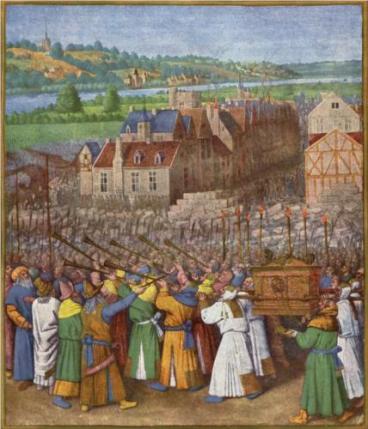
Joshua fittin’ the battle of Jericho, which sat on a major earthquake fault (Noise Curmudgeon)
So the actual name of Jesus the person would have been “Y’shua” (Yod-Shin-Vav-Ayin) Y’-Sh-U-A. This spelling had evolved over centuries from “Yeshua”, which had, by the fifth century BCE, evolved from Yehoshu’a (“Yahweh is salvation” or “Yahweh will deliver”). Thus Y’shua, Yeshua and Yehoshu’a have all come down to us as “Joshua.” The name “Joshua” appears in seven books of the Jewish testament, most notably as the one who “fit the battle of Jericho,” as the song goes.
Jesus = Joshua = Yeshua = Yehoshu’a. But there’s more. Yeshua’s father was Joseph, which through similar changes was transliterated from Aramaic Yôsēp̄ and Hebrew Yossif (יוֹסֵף֙ – Yoseph “he will add”) . In Hebrew “ben” was added to indicate “son of,” as in Ben-Hur (“son of Hur”) or Ben-Gurion; this became “bar” in Aramaic, as in “Bar-Abba[-s]” or “Barabbas” (“son of Abba[-s]” = “son of [informal ] God”) Matt 27-16
We can conclude that Jesus would have answered to the name Yeshua (or Y’shua) Bar-Yôsēp̄, a good Jewish Aramaic name. This brings us to a mystery, to be addressed in next week’s bible factoid. [Chuck Almdale]
Additional Sources:
Handbook of Birds of the World (HBW), Vol. 7. del Hoyo, J., Elliott, A. & Sargatal, J. eds. (2002) Lynx Edicions, Barcelona. Acorn Woodpecker – Pgs 441-442.
Handbook of Birds of the World (HBW), Vol. 13. del Hoyo, J., Elliott, A. & Christie, D.A. eds. (2008) Lynx Edicions, Barcelona. Shrikes, Loggerhead Shrike – Pgs 744-747, 785-786.
Handbook of Birds of the World (HBW), Vol. 14. del Hoyo, J., Elliott, A. & Christie, D.A. eds. (2009) Lynx Edicions, Barcelona. Nutcrackers, Clark’s Nutcracker – Pgs 611-613.
Birder’s Handbook. Ehrlich, Paul R., Dobkin, David S. & Wheye, Darryl. (1988) Simon & Schuster, New York. Pgs 344, 410, 466.
New English Bible with the Apocrypha, The, Oxford Study Edition. Sandmel, Samuel, Suggs, M. Jack, Tkacik, Arnold J.; eds. (1972) Oxford University Press, New York
Return To Top
Sunday Morning Bible Bird Study V:
The Friendly Ravens
Ravens weren’t discussed extensively in the bible – no bird was, for that matter – but they do appear in unexpected locations for interesting reasons. We begin with the citation from Genesis, briefly mentioned in Lesson I.
After forty days Noah opened the trap-door that he had made in the ark, and released a raven (הָֽעֹרֵ֑ב – ha-oreb “a raven” ) to see whether the water had subsided, but the bird continued flying to and fro until the water on the earth had dried up.
Genesis 8:6-7 New English Bible (NEB)
As previously mentioned, that’s all that Genesis says about this raven [עֹרֵ֖ב – oreb], not even whether it ever returned. It probably didn’t, preferring to follow its own agenda rather than Noah’s. Bible Factoid #1 noted that the precursor to this story – found in the much older Epic of Gilgamesh, written circa 2100 BCE – Utnapishtim (the “Noah” of the Gilgamesh) released a raven as the third bird, which found food and flew around and did not return.
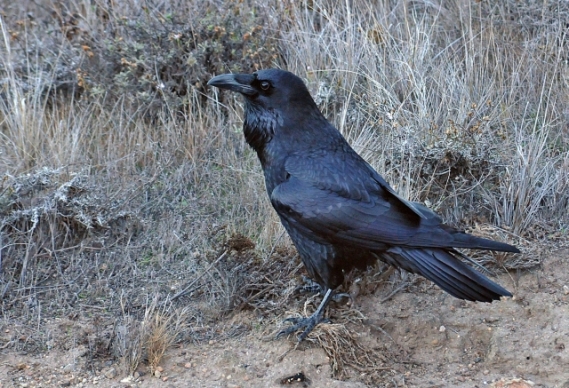
Common Raven, Santa Rosa (James Kenney, 11-24-12)
The raven was almost certainly the Common Raven (Corvus corax), the species we find today across North America and Eurasia. Their current range includes all of Europe and Asia Minor, northern Syria and Iraq, and nearly all of the southern and eastern edges of the Mediterranean Sea. Back then, forests in the Near East were more extensive and dense, attractive to our raven. Corvid family members are among the most intelligent and resourceful of birds, and the raven may be the brightest of the bunch, a good choice for any task requiring smarts. So smart, in fact, that they may well decide to skip your task and go do what they want to do. The tale of Noah, perhaps inadvertently, reflects this characteristic.
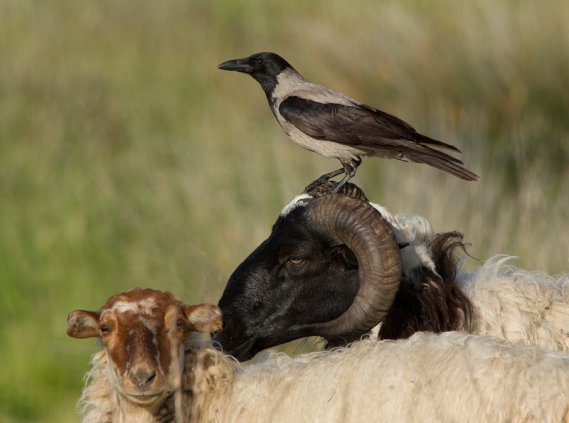
Hooded Crow on sheep’s head
(Jamie MacArthur, DeviantArt.com)
There are other dark corvids living in the vicinity. Hooded Crow (Corvus corone), about 25% smaller than the raven, is resident from Asia Minor down the Mediterranean eastern shore and the Nile River valley. Jackdaw (Corvus monedula) shares this area, but is largely grey and half the size of the raven. Brown-necked Raven (Corvus ruficollis) is a bird of desert and dry steppes. Their range currently stops south of the Mediterranean southern shore, but includes eastern Israel, Jordan, etc. Their range likely stopped even farther south in biblical times, as it was three millennia closer to the ice age.
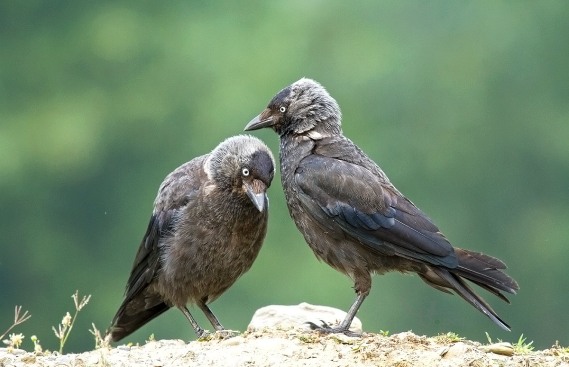
Jackdaws, India (Wikia)
Hebrew had only one word עֹרֵב – oreb for raven or crow; bible translators used both at different times, but Common Raven is likely our bird. Incidentally, Hebrew uses positional case-marking on nouns. Notice the progressive increase in Hebrew word length: “raven” עֹרֵב – oreb, “a raven” הָֽעֹרֵ֑ב – ha-oreb, “the ravens” הָעֹרְבִ֣ים – ha-oreb-im, and “and the ravens” וְהָעֹרְבִ֗ים – we-ha-oreb-im.
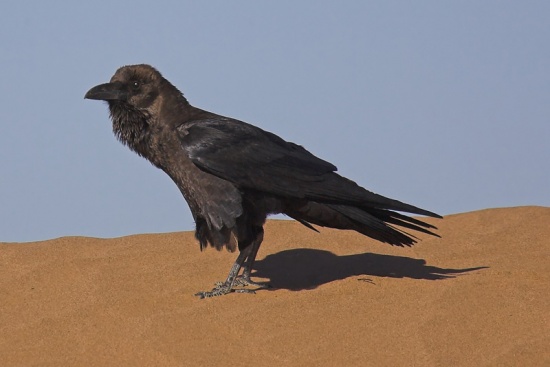
Brown-necked Raven, Hamada du Draa, Morocco
(Momo, February 2007)
Benjamin the Ravin
Our next citation is actually a red herring.
…Benjamin shall raven (יִטְרָ֔ף – ytrp, “yitrap”) as a wolf: in the morning he shall devour the prey, and at night he shall divide the spoil… Gen. 49:27 1599 Geneva Bible
Many words in the Jewish Hebrew and Christian Greek bibles occur only once*; יִטְרָ֔ף (“ytrp” or “yitrap”) is one of them. Such words usually create arguments because determining their meaning is little more than guesswork. The first KJV edition had “ravin”, later changed to “raven,” creating additional confusion. This obsolete word meant “to take away (goods) by force; to seize or divide as spoil.” Oxford English Dictionary’s last citation in this sense dates from 1625, fourteen years after the KJV was published. Nowadays we say ravening or ravenous. * See list at bottom
“Benjamin is a ravening wolf: in the morning he devours the prey, in the evening he snatches a share of the spoil.” Gen. 49:27 NEB
Inedible Ravens
Ravens next appear as members of two equivalent – but not identical – lists of twenty unclean birds.
“These are the birds you shall regard as vermin, and for this reason they shall not be eaten….every kind of crow [or raven] ( עֹרֵ֖ב – oreb )…” Lev 11:13-14 NEB
“These are the birds you may not eat…every kind of crow [or raven] ( עֹרֵ֖ב – oreb)…” Deut 14:12-14 NEB
This list will be covered in a later lesson. Nearly all twenty birds are birds we wouldn’t want to eat today, consumers of dead animals lying on the ground: cormorants, raptors, vultures, gulls. Most – if not all – corvids fall into that category, and the phrase “any kind of raven (or crow)” makes good sense. Four of the forbidden twenty are cited as “every kind of…;” the other sixteen birds are individually named.
The Friendly Ravens
Then the word of the Lord came to him [Elijah the Tishbite]: ‘Leave this place and turn eastwards; and go into hiding in the ravine of Kerith [Cherith] east of the Jordan [River]. You shall drink from the stream, and I have commanded the ravens (הָעֹרְבִ֣ים – haorebim “the ravens”) to feed you there.’ He did as the Lord had told him: he went and stayed in the ravine of Kerith east of the Jordan, and the ravens (וְהָעֹרְבִ֗ים – wehaorebim “and the ravens”) brought him bread and meat morning and evening and he drank from the stream.
1 Kings 17:2-6 NEB
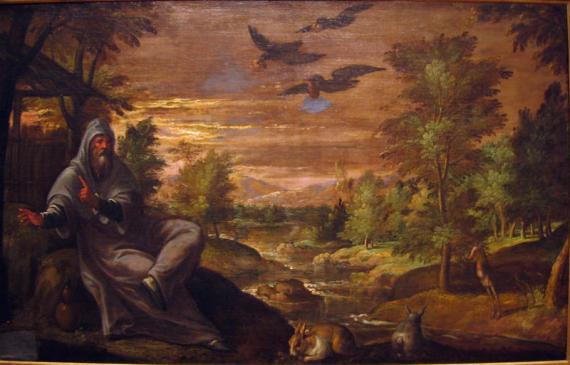
The Prophet Elijah fed by the ravens, Paulwels Frank, 1590 (Alterpersanium.com)
When Israel’s King Ahab didn’t fully appreciate Elijah’s prophesy, Elijah suddenly felt that the deity was telling him to make himself scarce, hide in the wilderness, and live off the land. The “ravens” would help him survive.
As always, commentaries and disagreements abound.
Matthew Henry: God could have sent angels, yet chose lowly ravens because even they would do what he asked.
Barnes: Most ancient versions translate as “ravens;” others translate as “Arabians” or “merchants” (ma-arab). Jerome [Latin Vulgate translator] took it as “Orbites“as does the Arabic Version.
Jamieson-Fausset-Brown: Sending unclean birds to feed Elijah is so bizarre that many choose “Orebim,” meaning merchants, or Arabians (we-ha-ar-bim), or citizens of Arabah, near Beth-shan (ha-a-ra-bah ). But “ravens” is preferable.
Cambridge Bible: The Septuagint says “ravens.” Jerome’s biography of Paul the Hermit says a raven supplied the hermit’s wants. Observers say large birds like ravens commonly carry home large quantities of food.
Pulpit Commentary: Some say הָעֹרְבִ֣ים (ha-o-ra-bim “the ravens”) must be ravens; men – smarter and lazier – would leave enough food for several days. But if Elijah were among kinsmen, friends, or Arab Bedouin following the law of hospitality, they might visit regularly such an honored guest. Visits might be made at twilight to avoid the day’s heat or discovery by authorities. The “orabim” are not ravens but men: kinsmen, friends, Bedouins or inhabitants of Orbo near Beth-shan.
Pulpit Commentary 1 Kings 17:4, comment 4. Both a rock named Oreb and a town named Orbo were in the area. Ha-o-ra-bim “Orbites” refers to inhabitants near the rock or of the town.
Clarke’s Commentary: Bereshith Rabba, an ancient Rabbinical comment on Genesis, says [Hebrew omitted] “Air hia betachom Beithshan, veshemo Orbo.” “There is a town in the vicinity of Bethshan (Scythopolis), and its name is Orbo.”
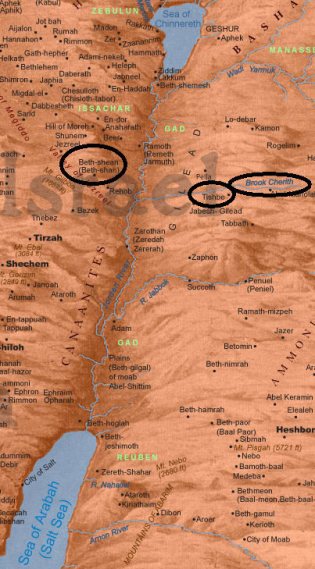
Old Testament Israel: circled Beth-Shan, Tishbe, & Brook Cherith
(Bible-history.com)
When even professional biblical scholars, believing these passages are Holy Scripture, can’t agree whether “ravens” are really ravens, we neophytes might do best by using probability. What’s the likelihood of being fed morning and evening for a year by wild ravens, versus being fed by friendly humans, perhaps one’s own relatives? Consider what the map shows: Tishbe – the home of Elijah “the Tishbite” – lies just south of Brook Cherith in Giliad, and about twenty-three miles “as the raven flies” across the Jordan River from Beth-Shan (Orbo is in Beth-Shan’s “vicinity.”) It’s pretty clear that Elijah was hiding out in his old stomping grounds, among friends and family, no birds needed. But we report – you decide.
Other Biblical Uses for Ravens
The raven is one in a litany of reasons why Job should stop complaining about the way God treats him.
Who provideth for the raven his prey, when his young ones cry unto God, and wander for lack of food? Job 38:41 Holy Scriptures according to the Masoretic Text (HSMT)
A similar metaphor is included in a litany of God’s good acts.
He giveth to the beast his food, and to the young ravens which cry.
Psalms 147:9 HSMT
Ravens will punish a wicked child.
The eye that mocketh at his father, and despiseth to obey his mother, the ravens of the valley shall pick it out, and the young vultures shall eat it. Proverbs 30:17 (HSMT)
The black color of the raven is used as a simile:
His head is as the most fine gold, his locks are curled, and black as a raven. Song of Solomon 5:11 (HSMT)
Our final raven is a parallel to last week’s citation from Matt 6:25-27, about anxiety, but this writer specifies ravens rather than the generic “birds of the air.”
Think of the ravens; they neither sow nor reap; they have no storehouse or barn; yet God feeds them. You are worth more than the birds! Is there a man among you who by anxious thought can add a foot to his height? If, then, you cannot do even a very little thing, why are you anxious about the rest? Luke 12:24-26 NEB
The bible mentions ravens eleven times. Beyond the facts that they are black, have young which cry and are fed, experience no anxiety, enjoy pecking at eyeballs, may be mistaken for one’s friends, and are unreliable errand-runners, the bible has little to say about this very intelligent, successful and admirable bird.
Bible Factoid #5 – The Bar-Abbas Mystery
Even among true believers, this is among the most debated of New Testament stories. Previously we learned: “Bar” means “son of” in Aramaic; the gospels cite Jesus – when speaking of God the Father – as saying “abba,” an Aramaic intimate word for “father;” “papa” or “daddy” is an English equivalent. “Bar-Abbas” means “son of Papa;” the “-s” ending is the Greek masculine addition. Mama, papa, baba, dada, abba – in any language, these nouns derive from baby talk, the first sounds a human infant can utter.
At the festival season it was the Governor’s custom to release one prisoner chosen by the people. There was then in custody a man of some notoriety, called Jesus Bar-Abbas (Βαραββᾶν – Barabban**). When they were assembled Pilate said to them, ‘Which would you like me to release to you – Jesus Bar-Abbas, or Jesus called Messiah?’….they said, ‘Bar-Abbas’. ‘Then what am I to do with Jesus called Messiah? Asked Pilate; and with one voice they answered ‘Crucify him!’….He then released Bar-Abbas to them; but he had Jesus flogged, and handed him over to be crucified. Matt 27:15-26 NEB
**Greek uses the -s ending when the noun is subject (nominative case), -n when noun is object (accusative case).
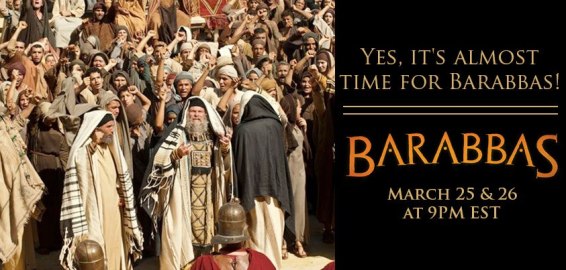
Barabbas mini-series poster (Crossmap.com , 2016)
There are several problems with this story. First, no written record exists anywhere – not Jewish, not Roman, not Christian – beyond this paragraph in each of the four gospels (the other three gospels borrowed from Mark) of the existence of any custom of releasing one prisoner upon request during Passover season or at any other time. Scholars not wedded to a belief in biblical literal truth and who appreciate supporting evidence doubt this story’s veracity.
Second, Jesus frequently referred to himself and others as sons or children of God the “Father” – fifty times in the four gospels. By the time he was hauled before Caiaphas the High Priest, Herod the King and Pilate the Roman Governor, this usage of “Abba” and “Father” was well known and they asked Jesus about it. Our story is saying that we now have two men called Yeshua (Jesus) Bar-Abba (Barabbas, “son-of-[intimate form of] father”). Two men called Yeshua bar-Abba – one a criminal, one a preacher.
Scholars and mystery-lovers ask: When the crowd called for Bar-Abba to be released – whom did they want, whom did they get? When they called for Yeshua to be crucified – whom did they want, whom did they get? Some scholars, including Hyam Maccoby, maintain that Jesus was commonly known as “bar-Abba” for his custom of addressing God as ‘Abba’ in prayer, and for referring to God as ‘Abba’ in his preaching. When the crowd told Pontius Pilate to “free Bar-Abba!” they meant preacher Jesus. There was no criminal Jesus present.
If we assume the story of setting one bar-Abba free is false, as many scholars maintain, why does the story exist at all? What purpose does it serve? To place blame on the Jews, many say; to make Christianity acceptable to Roman authorities. By the time the Gospels were written, Roman anti-Judaism had begun (c. 40 CE), the Jewish rebellion collapsed (66-73 CE, Jerusalem and the Second Temple were destroyed (70 AD), Masada had fallen (74 CE), the Diaspora quickened, Jews had lost favored status to practice monotheism rather than worship Roman Gods and the Emperor, and pretending to be a Jewish sect no longer protected Christians from oppression. What better way to disconnect from Judaism and curry favor with Roman authorities than to place blame for Jesus’ death onto the Jews. Thus many scholars view the gospels as partially polemic and apology, saying in effect to the Romans, “We don’t blame you, we blame the Jews. We’re no threat to you. We’re good Roman subjects. We ‘render unto Caesar what is Caesar’s…’”

The “disciple whom Jesus loved”- John 19:26 (James, John or Mary Magdalene?) sits at Jesus’ right hand, detail of Da Vinci’s Last Supper (Daily Mail)
Proffered explanations of the Bar-Abba story are legion. Here’s a sampling.
1. Two men: Yeshua crucified, Bar-Abba set free, as the Gospels say.
2. Two men: Bar-Abba crucified, Yeshua set free.
2a. Yeshua survived, met his followers afterwards, inspired them to carry on, the story ends.
2b. Yeshua went to France with or without one of the Mariams (Mary), settled down, had kids.***
3. One man Yeshua “bar-Abba:” religious preacher and insurrectionist, executed.
4. One man Yeshua “bar-Abba:” rebel insurrectionist, executed.
5. One man Yeshua “bar-Abba:” entire“bar-Abba” story invented to shift blame from Romans to Jewish leaders for bribing the crowd to call for the other “bar-Abba.” Pilate could release anyone, anytime without approval, permission or ceremony, and had done so previously.
6. One man Yeshua “bar-Abba:” Mark invented parable of Yeshua as the innocent “scapegoat” and “bar-Abba” symbolizes all sinners redeemed, set free by Yeshua’s willing sacrifice.
7. One man Yeshua “bar-Abba:” Greek-speaking “Mark,” utilizing story of crowd calling “bar-Abba” when asking for Yeshua’s release, invented Barbbas to explain misunderstood apparent presence of a second man.
8. One man Yeshua “bar-Abba:” Pilate (typically described as hard and iron-fisted) taunts the crowd. When they called for “son of papa” to be released, Pilate crucified him anyway.
9. The gospels are fiction: based on the life of otherwise unknown itinerant preacher.
10. The gospels are fiction: based on the life of otherwise unknown failed revolutionary.
11. The gospels are fiction: inspired by and stolen from the pre-Zorastrian religion of Mithras.
12. The gospels are fiction: “Jesus” is a corruption of name of Greek God “Zeus.”
13. And on and on and on.
***2b. This is the route followed by Holy Blood, Holy Grail (Baigent, M., Leigh, R. & Lincoln, H.), the 1982 “non-fiction” book upon which Dan Brown relied for the “factual” superstructure of his bestseller The Da Vinci Code.
Lacking adequate information, opinions proliferate and grow ever more fanciful. [Chuck Almdale]
*A Sampling of Rare Biblical Words
Raven or ravin (יִטְרָ֔ף – ytrp, “yitrap”) 1 occurrence
Crow or raven ( עֹרֵ֖ב – oreb ) 3 occurrences
A raven (הָֽעֹרֵ֑ב – ha-oreb) 1 occurrence
The ravens (הָעֹרְבִ֣ים – haorebim) 1 occurrence
And the ravens (וְהָעֹרְבִ֗ים – wehaorebim) 1 occurrence
Merchandise (מַעֲרָב– ma-arab) 9 occurrences
Citizens of Arabah (or Oreb) (הָעֲרָבָ֑ה – ha-a-ra-bah) 3 occurrences
[Chuck Almdale]
Additional Sources:
Handbook of Birds of the World (HBW), Vol. 14. del Hoyo, J., Elliott, A. & Christie, D.A. eds. (2009) Lynx Edicions, Barcelona. Corvids – Pgs 617, 630-631, 637-639.
Holy Scriptures: According to the Masoretic Text. (1955) The Jewish Publication Society of America. Philadelphia, Pa.
New English Bible with the Apocrypha, The, Oxford Study Edition. Sandmel, Samuel, Suggs, M. Jack, Tkacik, Arnold J.; eds. (1972) Oxford University Press, New York
Return To Top
Sunday Morning Bible Bird Study VI:
The Humble Hoopoe
The Hoopoe is another member of the list of twenty Unclean Birds whom we’re not supposed to eat. This list comes in numerous versions due to the problems of translating ancient and rare Hebrew words, but that’s a topic for a later lesson. For now, we’ll stay with the Hoopoe, a bird common in Eurasia and Africa, yet most uncommon in ways we shall see.
And these ye shall have in detestation among the fowls; they shall not be eaten, they are a detestable thing….the hoopoe… (הַדּוּכִיפַ֖ת – had·dū·ḵî·p̄aṯ “the hoopoe”)*
Lev 11:13-19 Holy Scriptures accor4ding to the Masoretic Text (HSMT)
Of all clean birds ye may eat, but these are they of which ye shall not eat….and the hoopoe… (וְהַדּוּכִיפַ֖ת – wə·had·dū·ḵî·p̄aṯ “and the hoople”)* Deut 14:11-18 HSMT
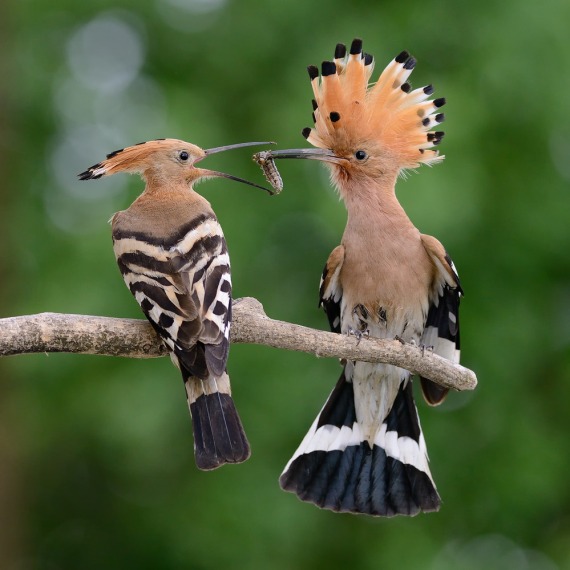
Eurasian Hoopoe pair – Upupa epops (Henry E. Hooper)
Slightly larger than an American Robin, a Hoopoe is 11-12″ long, including its slender and slightly decurved 2″ bill. It weighs only 1½ -3 ounces, the same as your quarter-pound hamburger after cooking. The head, neck, breast and belly colors varies from rufous to cinnamon to tawny; the wings and tail are black with irregular white bands; the bill, eyes and legs are black; the long crest feathers are tipped in black. It is an attractive, lively and inquisitive bird. Its name is unlikely to be forgotten or mistaken because for most people who know it, the name is echoic of its call, which varies from hoop-hoop to oo-poo-poo. [Video & call link]
The scientific name is Upupa epops (Latin name upupam + Greek name έποπα). Some other common names are: Arabic hud-hud, Dutch hoppe, French Huppe, Italian upupa, Maltese Daqquqa tat-toppu, Polish Dudek, Portuguese poupa, Spanish Abubilla, Turkish ibibik.
They are distantly related to the kingfishers. On their “birds of prey” branch of the Tree of Life, they split from Owls 75.9 million years ago (MYA), from Trogons 72.1 MYA, from Kingfishers & Bee-eaters 69.6 MYA, from Hornbills 55.3 MYA and from Woodhoopoes & Scimitarbills 35.2 MYA. [Don’t rely on the permanence of these dates. Research continues.]
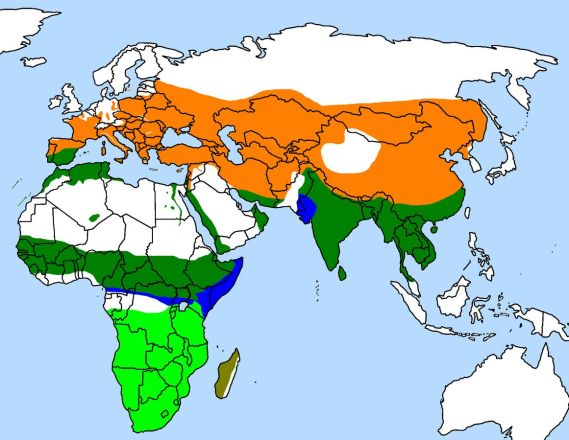
Range of the Hoopoe: Orange-breeding, Light & Dark Green-resident all year; Blue-winter; Brown – Madagascar species (Wikipedia)
Their nesting begins as early as mid-April around the Mediterranean; in Northern Europe as late as early June. Nesting behavior of non-migratory resident birds cycles around the rainy seasons. Nest are in tree cavities, walls, cliffs, earth banks or termite mounds. The female incubates 4-6 (sometimes as many as 12) blue, gray, green, yellow or brown eggs for about 18 days. The male brings her food, but no water, as they are not known to drink. They don’t remove the eggshells or fecal sacs of their young, unlike most other cavity-nesting birds. The young – helpless with sparse down when hatched – fledge (leave the nest) in 3 to 4 weeks,
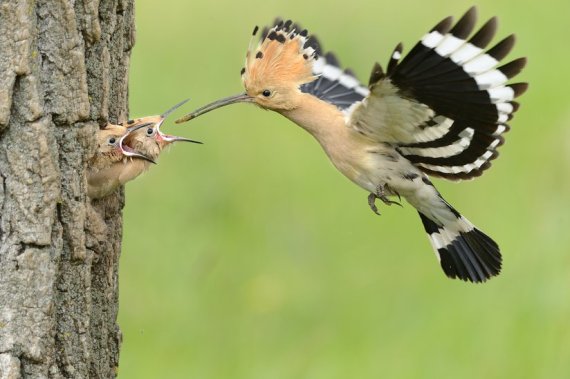
Feeding the young on the fly (Cowboy54 – From The Grapevine)
and may stay with their parents until nesting season returns. They feed on the ground and use trees for safety and night roosting. Their typical flight is slow, undulating and a bit haphazard, belying their impressive speed and maneuverability should a falcon take pursuit. Their long crests – normally held flat – may be raised in excitement or alarm. They can be found alone or in small bands which are probably family units, but they are not gregarious. Hoopoes can be tamed; one became accustomed to eating a boiled egg for breakfast.
Shorebirds and waders often have chunky bodies and long slender bills, but they usually stay close to water, when not actually in it. In the Hoopoe’s preferred dry, park-like habitat, only Lapwings remotely resemble them.
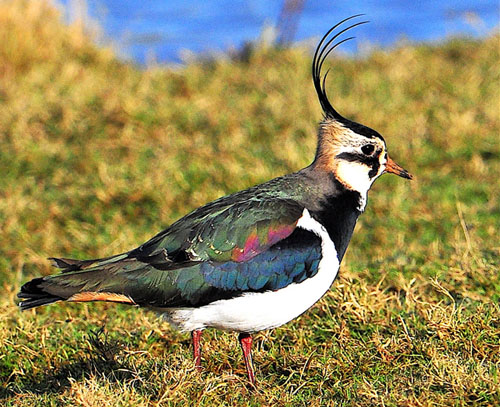
Northern Lapwing – Vanellus vanellus
(John Sheppard – Sulgrave, GB)
Until recently the Hoopoe was classified into ten subspecies, but one was split off as Madagascar Hoopoe Upupa marginata (a decision lacking universal scientific agreement), leaving the rest of the Hoopoes stuck with the less euphonious name, Eurasian Hoopoe.

Madagascar Hoopoe -Upupa marginata
(Matthew Golding – Flickr photo)
Hoopoes have been admired for millennia and are well-represented in our art. Bartolo’s often reproduced painting, St. Francis Preaching to the Birds, depicts a pheasant, a quacking duck, several small birds in a tree and a Hoopoe in the foreground on the ground, all paying rapt attention to the words of this,
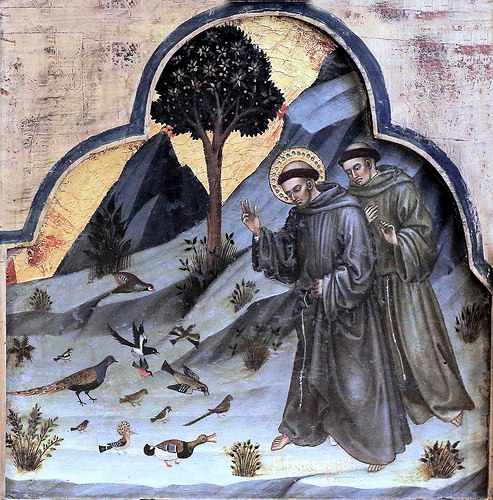
St. Francis Preaching to the Birds – Find the Hoopoe, Taddio di Bartolo, 1362-1422 (Jean Louis Mazieres – Flickriver)
presumably their favorite saint. There are two stories of Francis involving preaching and birds. The first is that Francis and friends were walking through the Spoleto Valley of Italy when he spotted a flock of birds and ran over to them. “Beloved birds,” he greeted, expecting them to fly away. They stayed, and he preached while they silently listened. The second is that Francis, preaching to a crowd from a balcony in Alviano, had to contend with swallows building nests nearby and chattering noisily. Francis finally called to them, “My sisters, swallows, it’s my turn to speak now, because you’ve already said enough. Listen to the word of God. Stay still and be quiet until it’s over.” Reportedly the swallows fell silent until Francis finished. Francis seems to have loved everyone and everything. Would that today’s Italians felt as friendly towards their birds, rather than eating them all, large and small.
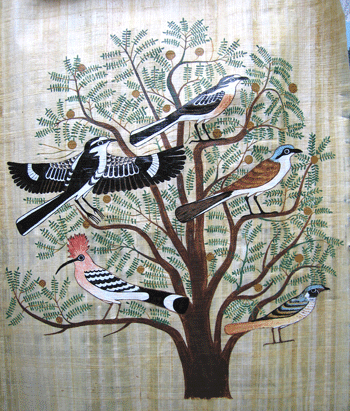
Bird tree with Hoopoe, Tomb of Khnun-Hotep, Middle Kingdom, Beni Hasan, Egypt (Timetrips.com)
Wall paintings in the Egyptian tomb of Khnum-hotep II, dated to 1950-1900 BCE, clearly shows a Hoopoe and many other birds.
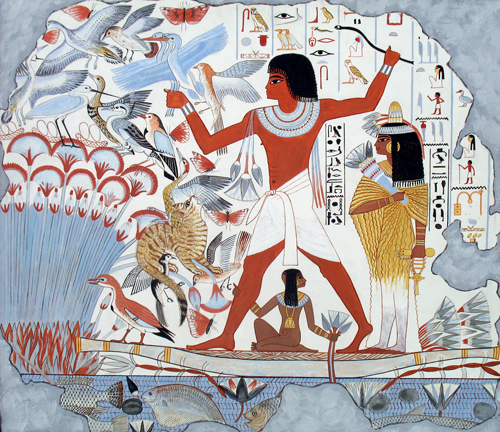
Neb-amun hunting birds in the marshes, Tomb of Khnun-hotep, Middle Kingdom, Beni Hasan, Egypt. No Hoopoes in the marshes. (Timetrips.com)
Many scientists say the Hoopoe is the sole species in their evolutionary family, Upupidae. Humans are similarly alone; our cousin Homo species are long extinct, probably at our hand. The Old World range of the Hoopoe virtually replicates ours at the end of the last ice age. They dislike large bodies of water and never made it to Australia, most of Japan or the New World, although they occasionally stray across the channel to England.
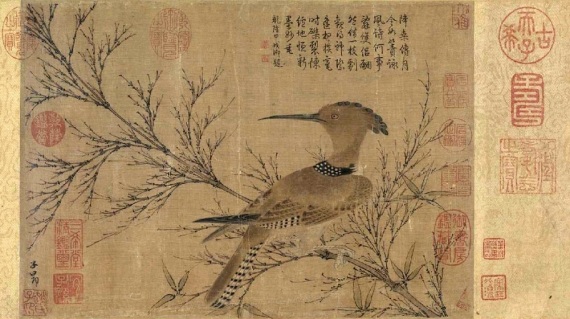
Hoopoe on Bamboo, Zhao Mengfu 1254-1332 (Wikipedia – Shangai Museum)
Ever since Homo erectus, our predecessor species, left Africa and wandered to the far reaches of Eurasia, our ancestors have found Hoopoes close at hand. Throughout our shared range we find them in savannas, open woodlands, forest clearings, cultivated ground and gardens, probing the ground with their long slender bills. As we adapted to life as herdsmen and farmers, Hoopoes remained nearby, gleaning our pastures and fields. The snails, spiders, centipedes, ant-lions, and lizards which they gleaned from our gardens and fields and ate within our easy eyesight, is what branded them an Unclean Bird. [Snails were definitely a no-no.] Divine taboos were not placed on tiny forest birds unnoticed by human eye, no matter how loathsome and lethal to humanity their choices in cuisine might be. Hoopoes gave us their lively beauty and ate our pests. Sometimes our landscape changes suited them; sometimes not. Mostly, we coexisted.
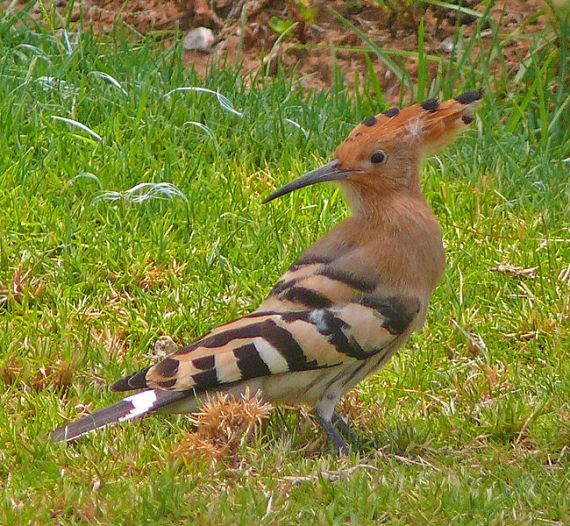
Israel’s National Bird in Ramat Gan (Zachi Evenor 5-22-10, on Wikipedia)
Hoopoes and Humanity: Fellow Passengers on Spaceship Earth
Hoopoes and humans are orphans; solitary species within our respective families. The large mammals preserved in La Brea pits were probably hunted into extinction by humans. Australian species vanished when Aborigines burned the landscape to suit their own needs. The aurochs, cave bears, elephants and rhinos of Europe are gone. Half of Hawaii’s bird species disappeared during the millennia between the arrivals of Polynesians and Euro-Americans. Humans are a dangerous species and the future of any creature that gets in our path is not promising. Our only successful adversaries are those who avoid confrontation and, like water, seek the low road, remaining obscure, like bacteria, rats and cockroaches. But through all the changes and depredations of human history, Hoopoes held their noble visibility, sharing our lands and lives, yet staying at arm’s length, neither dangerous nor useful to us.
Humans typically exhibit an anthropocentric view of nature – “What does it do for me?” This attitude may muster economic forces to protect species or habitat, because, “Maybe we’ll find a cure for cancer!” We make much ado about the value of an individual’s life and freedom, yet rarely extend concern and courtesy to our fellow passengers on our earthly ark. Their lives have value for them as ours do for us, whatever one thinks of the other. If we understood that “dumb animals” participate as richly in their own lives as we do in ours, we might not act as we do towards them. What may we learn from them?
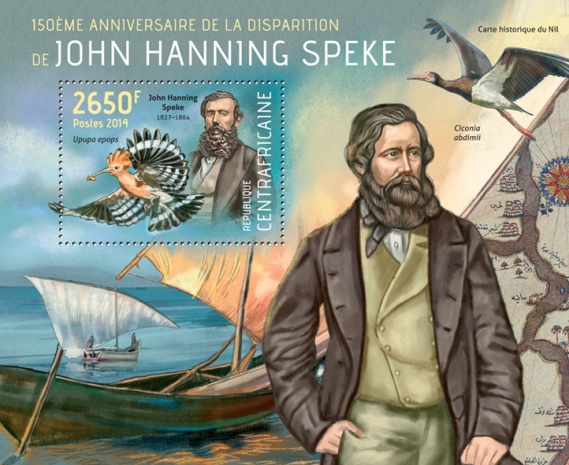
Explorer Speke, 1st European to see and map Lake Victoria, July 1858 (Central African Republic stamp)
Hoopoes are a good example of how the meek may yet inherit the earth. Better yet, perhaps they unintentionally do what Jesus, much later, told his disciples when he sent them out to preach:
“Behold, I send you out as sheep in the midst of wolves. Therefore be wise as serpents and harmless as doves. Matthew 10:16 New King James
Bible Factoid #6 – Catching Forty Winks
One way to do textual analysis and gain a glimpse into a writer’s mind is to find their favorite words and determine just how much they like them. All following citations are from the King James Version.
I will cause it to rain upon the earth forty days and forty nights… Genesis 7:4
…and Moses was in the mount forty days and forty nights…. Exodus 24:18
And forty sockets of silver he made under the twenty boards… Exodus 36:24
…the LORD thy God led thee these forty years in the wilderness… Deuteronomy 2:7
Being forty days tempted of the devil. And in those days he did eat nothing… Luke 4:2
To whom also he shewed himself…being seen of them forty days… Acts 1:3
As in modern parlance, “Forty? What’s up with that?”
What with all the armies and ages and apostles, numbers are very common in both Jewish and Christian scriptures. We even find an important Jewish scripture, fourth book in the Torah (Pentateuch) entitled “Numbers” in the Christian version. [The Jewish version is more appropriately titled “In the Wilderness.”] So let’s look at some numbers.
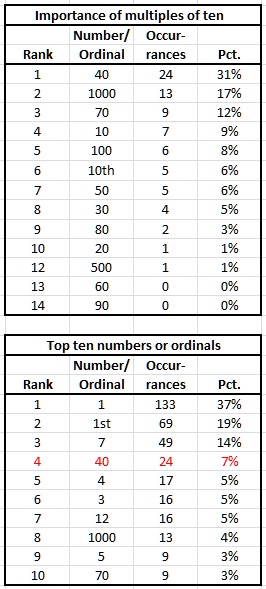
I combed through my bible concordance, counting citations for all numbers (one, two, etc.) and ordinals (first, second, etc.). It didn’t give all citations – just significant ones. I discovered that “forty” was by far the most common of multiples of ten between ten and one hundred (first chart). Among all numbers (second chart) it was fourth, surpassing 1000, 100 and even 10 itself.
BibleStudyTools, a great online site for biblical nit-picking, lists 145 occurrences for the word “forty.” Here “forty” rates only sixteenth, but this list includes all citations of the word, such as:
Those that were numbered of them, even of the tribe of Gad, were forty and five thousand six hundred and fifty.
Numbers 1:25
The verse above counts as one citation each for: forty, five, thousand, five thousand, six, hundred, six hundred, and fifty. These sorts of biblical citations are innumerable (pun intended). There are fourteen citations like this one, every one beginning with “forty and xxx thousand…” Although this exceeds the limits of randomness, I did not include citations such as these in my two charts.
Thirty-nine citations referred to counts of various sorts: “So all the cities which ye shall give to the Levites shall be forty and eight cities…” (Numbers 35:7) Seven citations referred to ages: “Then said the Jews, Forty and six years was this temple in building…” (John 2:20) I didn’t included these either.
Six citations referred to the flood, twenty to Moses on his various mountains, ten for Israelites wandering in the Sinai desert, four for Jesus meditating in the desert. Such clusters were counted as one citation each.
After subtracting 121 citations of low or no significance, twenty-four remained. I examined sixty different numbers; three had greater frequency than “forty.” Not unexpectedly, they were “one,” “first” and “seven” (second chart) “One” and “first” need no explanation of significance; “seven” is a magical number in many cultures and religions, and its high frequency was expected. For the same reason, I expected “three” to be higher than its 6th place rating. At the bottom, “sixty” and “ninety” were never used meaningfully (symbolically).
So, again…what’s up with forty?
The most common opinion is that forty symbolizes trial, testing or judgment.
And the rain was upon the earth forty days and forty nights. Genesis 7:12
And the children of Israel did eat manna forty years… Exodus 16.35
And [Moses] was there with the LORD forty days and forty nights… Exodus 34:28
…the LORD delivered them into the hand of the Philistines forty years. Judges 13:1
And Jonah…said, Yet forty days, and Nineveh shall be overthrown. Jonah 3:4
And [Jesus] was there in the wilderness forty days, tempted of Satan… Mark 1:13
There is also the legal limit on lashes, which can certainly be considered a “trial.”
Forty stripes he may give him, and not exceed… Deuteronomy 25:3
Another explanation is that forty symbolizes a “generation of man.”
And Esau was forty years old when he took to wife Judith… Genesis 26:34
And your children shall wander in the wilderness forty years, and bear your whoredoms, until your carcases be wasted in the wilderness. Numbers 14:33
And the land had rest forty years. And Othniel the son of Kenaz died. Judges 3:11
To whom also he shewed himself alive after his passion by many infallible proofs, being seen of them forty days, and speaking of the things pertaining to the kingdom of God. Acts 1:3

Versions Nos. 1 – 39
didn’t work so well
(Wikipedia)
One source claims:
According to saint Augustin, forty expresses the perfection ‘because the Law was given in ten commandments, then it is through the whole world that the Law has been preached, and the whole world is composed of four parts, Orient and Occident, South and North; therefore, by multiplying ten by four, we obtain forty.’
I didn’t know that St. Augustine had enough imagination to come up with that doozy.
But the two popular explanations don’t cover the many dozens of non-random appearances of “forty.” I have the suspicion that it was also used as we use “dozens,” “bazillion” or “many” – an indefinite large number that simply sounds good to our ears.
Those that were numbered of them, even of the tribe of Reuben, were forty and six thousand and five hundred. Numbers 1:21
About forty thousand prepared for war…to the plains of Jericho. Joshua 4:13
…and David slew the men of seven hundred chariots of the Syrians, and forty thousand horsemen… 2 Samuel 10:18
And Solomon had forty thousand stalls of horses for his chariots… 1 Kings 4:26
Then made he ten lavers of brass: one laver contained forty baths… 1 Kings 7:38
In the four corners of the court there were courts joined of forty cubits long and thirty broad… Ezekiel 46:22
The writers of the bible didn’t do that with “sixty” or “ninety.” That’s something to think about while you’re trying to catch forty winks. [Chuck Almdale]
*The word “hoopoe” comes in two forms in the bible.
הַדּוּכִיפַ֖ת (had·dū·ḵî·p̄aṯ) “the hoopoe” 1 occurrence Lev 11:19
וְהַדּוּכִיפַ֖ת (wə·had·dū·ḵî·p̄aṯ) “and the hoopoe” 1 occurrence Deut 14:18
The root word דּוּכִיפַת (dū·ḵî·p̄aṯ) does not actually occur in the bible.
Additional Sources:
Tree of Life To navigate Tree Of Life, click binoculars icon in upper right corner, enter bird name and press “next hit” until you get to your bird.
BibleHub.com An invaluable tool. Almost a “one-stop-shopping” research site for the bible.
BibleStudyTools.com A very useful site.
1. Birds of Europe. Mullarney, K., Svensson, L., Zetterström, D., Grant, P.J. (1999) Princeton University Press, Princeton, N.J. – Pg 220.
2. Dictionary of Birds. Campbell, Bruce. (1974) Peerage Books, London. – Pgs 22-23, 347.
3. Handbook of Birds of the World (HBW), Vol. 6. del Hoyo, J., Elliott, A. & Sargatal, J. eds. (2009) Lynx Edicions, Barcelona. Hoopoes – Pgs 396-411.
4. Holy Scriptures: According to the Masoretic Text. (1955) The Jewish Publication Society of America. Philadelphia.
5. Nelson’s Comfort Print Bible Concordance. Youngblood, Robert F. (1995) Thomas Nelson Publishers, Nashville, TN
6. New English Bible with the Apocrypha, The, Oxford Study Edition. Sandmel, Samuel, Suggs, M. Jack, Tkacik, Arnold J.; eds. (1972) Oxford University Press, New York
Return To Top
Alternative Scriptural Bird Study VII:
King Solomon, Queen Sheba, and the Hoopoe
Once upon a time, says the Quran, a Hoopoe was King Solomon’s personal messenger.
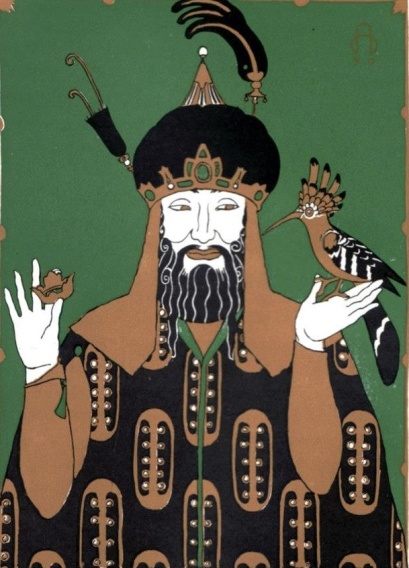
The Hoopoe – explorer, spy & messenger all rolled into one – sits on King Solomon’s hand (Google – Pinterest)
“And [Solomon] reviewed the birds, and he said, ‘Why do I not see the hoopoe (الْهُدْهُدَ), or is he of those absent? I shall surely punish him severely or slay him, or he must come to me with a clear excuse.’ But [the hoopoe] was not long in coming, and it said, ‘I have found out what you have not apprehended, and I come to you from Sheba with tidings!’ (Quran 27:20-22).” The bird reported that Sheba was ruled by a powerful and wealthy Queen who had a magnificent throne. But they worshipped the sun, which disturbed Solomon. Solomon sent the hoopoe back to the Queen with a letter, inviting her and her people to the worship of the one true God. Ultimately, Queen Sheba renounced idolatry and joined Solomon in worshiping God.
Solomon seems to have been a little testy with his employees. Other sources report that Solomon and the Queen got up to a lot more than the “worship of God,” but I doubt the Hoopoe was involved, so we won’t dwell on it.
In researching the Hoopoe in the Bible, I ran across this story from the Quran. It is interesting in its own right, it gives us a chance to take a brief look at this culturally foundational text, and it’s illuminating to compare these two books with respect to how they present material.

Bilquis, Queen of Sheba, gets a letter from King Solomon by means of his trusty Hoopoe. c. 1595, artist unknown, falsely attributed to Bihzad Iran, Safavid, Qazvin (Wikipedia)
The land of Sheba, depending on your source, was in Arabia, Ethiopia, Egypt, Nigeria, Iran, somewhere north of Assyria (whence the name Syria), or nowhere at all. Sheba could have been Saba in what is now Yemen. Take your pick. This sort of uncertainty of “facts,” or of incompatible certainties, brings us to something interesting about humans as a species.
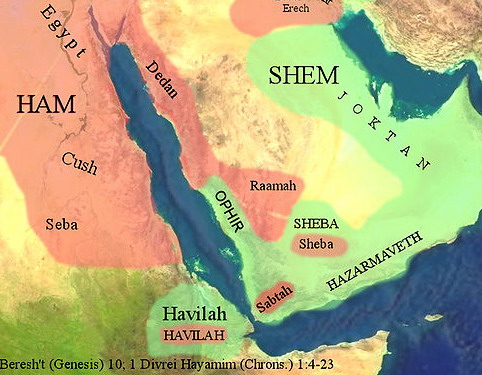
Map showing two of the many lands of Sheba or Seba. (Britam.org)
When we previously considered the problems presented by the stories of the two Bar-Abbas, and Elijah and his “friendly ravens,” we were doing a simple form of text analysis; we looked at alternative interpretations of the texts and reasons why they might have been written as they were. Writers write for human reasons. Their reasons may proliferate into the hundreds, yet we, as fellow humans, may sometimes ferret out something interesting by looking at what they wrote. We did this with Christian and Jewish scriptures; it’s only fair that we look at this Quranic story as well.
I couldn’t determine from the source link which translation from Arabic Quran they used. Its English is more modern (“surely“, not “verily“; “not apprehended“, not “apprehendest not“) than in my 1930 version, but otherwise equivalent.
The official Islamic view is “every single letter and word in the Koran comes directly from God” [Shadi Hamid, Los Angeles Times] [1], a view which out-fundamentalizes any Christian fundamentalist. Pew Research [2] has surveyed religious views, including Islamic, world-wide. In sub-Saharan Africa, the only region where respondents were asked whether they consider the Quran to be the word of God, they found “more than nine-in-ten Muslims say the Quran is the word of God, and solid majorities say it should be taken literally, word for word.” They did not ask that exact question of American Muslims, but found that 37% believe that there is only one true way [3] to interpret the teachings of Islam (28% of U.S. Christians believe that about Christianity). So we’ll take this viewpoint into consideration.
We’re going to look at this Surah (chapter) no. 27, given the title “The Ant,” which belongs to what’s known as the “middle group of Meccan surahs.” If you’ve never read any of the Quran (Koran, Q’ran), now’s your chance to be able to honestly say you’ve read some of it. Two good (it seems to me) translations are Clear Quran and Noble Quran. This surah has 93 verses and can be read in five minutes.
Very roughly, this surah is a sequential and rapid list of events in Jewish biblical history, which pauses only when arriving at King Solomon. Verses 1-15 consists of promises to unbelievers (unpleasant) and believers (pleasant), mixed with Allah’s frequent self-references – beneficent, merciful, mighty, wise, lord of the worlds, etc. Verses 16-44 pertain to Solomon, the Hoopoe and Queen Sheba. Verses 45-93 continue the rapid historical recitation, promises pleasant and unpleasant, and self-descriptions.

Gina Lollobrigida looks neither Ethiopian nor Yemeni. Note absence of the Hoopoe. (FFFMoviePosters.com)
Solomon is not a likable character. He is setting about to conquer whatever remains unconquered and is mustering his troops – avian, djinn (genies – intelligent spirits lower than angels) and human – and fulminating at the Hoopoe’s absence. The Hoopoe returns, tells his tale, and after delivering Solomon’s message to Sheba, vanishes from the story. Perhaps he wisely decided he’d had his fill of servitude under Solomon, a terrible boss, whatever his religious predilections might be. Sheba does not look forward to meeting Solomon and she tries to buy him off with expensive gifts. He then steals her beautiful throne and tells her it’s a replica when he later shows it to her. Somehow this and the shiny marble floor of Solomon’s palace convince Sheba to accept Solomon’s monotheism. After this, the surah takes a sharp left turn and Solomon and Sheba vanish as well.
[INTERJECTED NOTE: On 11 October, 2019, I received the following note from “Tuppence” <twopennyposts@gmail.com> (a “tuppence” is an almost-archaic Britishism for a two-penny coin), which I reproduce here in its entirety.
Hello Mr. Almdale,
It’s been a few years now since you did that Bible Birds series. I stumbled across your post about the Quran’s story of Solomon and the Hoopoe. It was very entertaining. I’ve been doing a Quran series myself and just studied this surah. Something that would help you understand the story a little more is to know that it is copying a document known as “The Colloquy of Sheba.” The manuscript we have does post-date the Quran, but Solomon-Sheba fanfics* are pretty old and I’d say by reading it that the Quran was referencing an older work.
https://en.wikisource.org/wiki/Translation:Colloquy_of_the_Queen_of_Sheba#cite_ref-18
The Quran is toning down the bizarreness of the story for the most part, while simultaneously assuming its audience knew the story enough to fill in gaps in the details. Or at least, that’s how I made sense of it. Anyhow, trivia on a post I’m sure is long dead in your concern. But thanks for posting! – Tuppence
*“Fanfics” is a neologistic portmanteau for “fan fiction,” defined as “any kind of work that is inspired by books, films, TV shows, music, and celebrities. It’s created and published by fans of the original work.” Tuppence’s comment does not make me want to change anything I’ve written in this article but it does raise a question. As “Colloquy of the Queen of Sheba and King Solomon” (title on the linked document) is dated to circa 800 C.E., and Muhammad died in 632 C.E., it makes things awkward. Perhaps he wrote this from beyond the grave, or the document is based on the surah, or both document and surah are based on an earlier version of the story. Whatever happened, it doesn’t lend much support towards the belief that every letter, or even every word, in the Quran comes directly from God. END OF NOTE.]
There are several problems with this story and its presentation. If this is literally from the mouth of a deity, as most Moslems maintain, it’s a very odd story, especially as it’s tucked into a litany of that deity’s own marvelous deeds and qualities. Solomon may be a powerful and religious king, but otherwise he seems poorly socialized. Sheba appears too easily persuaded by his thievery; more likely she’s stroking his masculine ego in order to avoid his laying waste to her land (27:34) with his army. Why is a deity telling us this story and in this form? Are we supposed to believe that these events actually happened as described, or is it a divine illustration of what submission to that deity’s will should look like and the wonderful things that befalls those who submit?
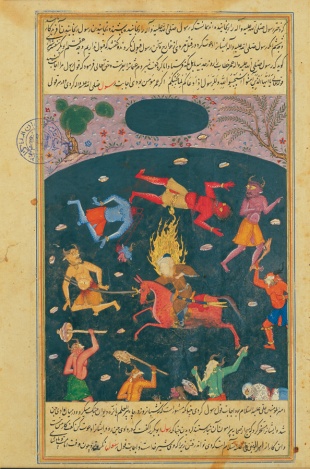
Imam Ali and the Jinn, 1568, Unknown Artist, Ahsan-ol-Kobar, Golestan Palace (Wikipedia)
First, we’ll assume the details are literally true. Are we supposed to believe that Solomon really had birds he could understand, knew the language of the ants, had genies in his army? Without flogging this assumption too much, it seems unacceptable that an infinite creator deity, lord of the worlds, would actually want and expect us to believe this story to be literally true. The content and form of the surah seems well below the capabilities of such a deity.
Second, we’ll assume this is a divine metaphor. If so, it’s a strange metaphor. We’re supposed to admire or emulate this depiction of Solomon? He is not a good person, and the depiction seems more degrading than exalting. Perhaps we’re supposed to understand that the deity will reward anyone who properly submits, even this greedy liar. I have more respect for wily survivor Sheba, and admiration for my hero of the tale, the Hoopoe. He got out. He probably lived out his days in Ethiopia, feeding fat grubs to his lovely children and bill-rubbing with his lady friend, far from the dangerous company of unworthy men. That is, of course, assuming that any of this entire story actually happened.
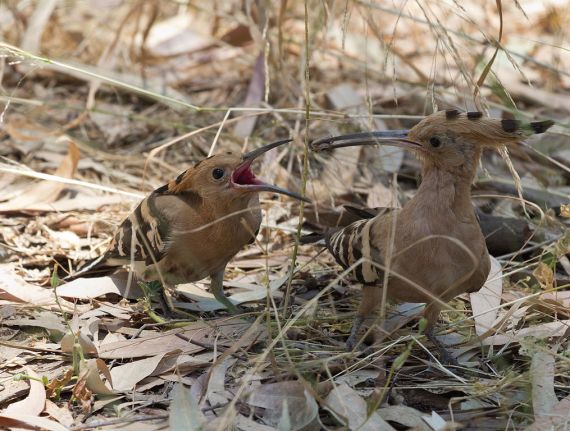
Hoopoe feeds the young one, Israel
(Artemy Voikhansky – Wiki Commons)

Magyar Posta (Hungary) 2010 stamp, Aladdin and the Jinn (Wikipedia)
The last possibility is that both assumptions above are false. This story is human-made, for human purposes. As this view does not ascribe peculiar qualities – especially with respect to the storytelling ability or self-absorption of an infinite creator deity – it seems the most acceptable view. A human or humans wrote it. Why did they write it in this peculiar, disjointed, episodic form?
I’m not the first reader to have a problem with this text. The translator of my Quran copy, Mohammed Marmaduke Pickthall, (and here) prefaced this surah:
Some commentators, objecting to the miraculous, seek to explain the ants, in the story of Solomon, as an old Arab tribe, the birds as cavalry, Hudhud (the hoopoe) as a man’s name, and the Jinn as foreign troops.
Aristotle wrote in his “Poetics” (Part IX):
Of all plots and actions the episodic are the worst. I call a plot ‘episodic’ in which the episodes or acts succeed one another without probable or necessary sequence. Bad poets compose such pieces by their own fault…

The Nightmare by John Henry Fuseli, 1781
(Detroit Museum of Art via Wikipedia)
I suggest that the form of this surah reflects its origin in a dream. Dreams often abruptly introduce characters and events; these may suddenly morph into other characters and events; people fly, animals and inanimate objects talk, angels or spirits of the dead appear and vanish; scenes evaporate and new scenes appear; people encounter gods and demons, and it all seems perfectly normal and true until the dreamer awakes.

Le Cauchemar – Eugene Thivier, 1894. In centuries past, hypnagogic dreams often included the sensation of an evil demon sitting on one’s torso.
(The Atlantic – Sleep Paralysis)
The hypnagogic dream – occurring between true dreaming sleep and true wakefulness – may contain any of the above, but with a critical added factor: the dreamer believes they are awake. Not just believes, but knows for certain they are awake and the dream is marvelously – or horribly – true. Even after the dreamer truly wakes and the hypnagogic state ends, this feeling of conviction of the dream’s truth continues – for hours, days, weeks, years, sometimes for a lifetime.

Modern hypnagogic dreams often manifest as abduction from your bed by extraterrestrials (EducatingHumanity.com)
(See also 72 Possible Signs of Alien Abduction)
As with any human trait, ability or defect, some people express, utilize or suffer with it more than others. This surah’s form – a rambling episodic narration abruptly morphing into a strange story with magical characters and peculiar illogical events, then equally abruptly reverting to the rambling narration – is dreamlike in every respect. I suggest that this surah originated in a hypnagogic dream and, as is characteristic of such dreams, the dreamer emerged from the dream convinced of the absolute reality of the dream. That they likely remained forever so convinced is demonstrated by the fact that the story exists at all. Most dreams are forgotten shortly after the dreamer awakes. Only dreams remarkable for content, clarity or emotional impact are retained in memory, related to others, perhaps even written down for posterity. The following famous story of Chuang Tzu, perhaps the greatest Taoist philosopher after Lao Tzu, illustrates this state of simultaneous certainty of two incompatible interpretations of reality, a state commonly engendered by the hypnagogic dream.
I, Chuang Tzu, dreamed I was a butterfly, flitting about happily enjoying myself. I didn’t know I was Chuang Tzu. Suddenly I awoke, and now I no longer know whether I am Chuang Tzu, who dreamed I was a butterfly, or whether I am a butterfly now dreaming that I am Chuang Tzu.

Dream within a dream?: Butterfly and Chang Zhu each dream they are the other (LikeSuccess)
Bible Factoid #7 – On “On”
Somewhere between three and six in the morning, seeing them laboring at the oars against a head-wind, he came towards them, walking on the lake. He was going to pass them by: but when they saw him walking on the lake, they thought it was a ghost and cried out: for they all saw him and were terrified. But at once he spoke to them: ‘Take heart! It is I; do not be afraid.’ Mark 6:48-50 New English Bible
Let’s compare that to a facsimile (PDF File, facsimile pg 1263) of the original 1611 King James Bible.
And he saw them toiling in rowing (for the wind was contrary unto them:) and about the fourth watch of the night, he commeth unto them, walking upon the Sea, and would have passed by them. But when they saw him walking upon the Sea, they supposed it had bene a spirit, and cried out. (For they all saw him, and were troubled) and immediately he talked with them, and saith unto them, Be of good cheer, It is I, be not afraid. Mark 6:48-49
The English used is obviously separated by centuries, but otherwise differences are minor. If you look at the linked PDF, facsimile pg 1263 facsimile, you’ll see that the small letter “s” looks like “f”, just as in facsimiles of the American Declaration of Independence.

2000 year-old fishing boat found at Sea of Galilee 1986 (drblyisrael15)
The Greek word for “on” (ἐπὶ “epi”) occurs 669 times in the New Testament. This preposition locates something in time or space, and is translated in the New Testament from Koine Greek into these English words: about, above, against, after, along, among, over, at, because, before, being, by, during, for, from, in, into, in the time, on, out onto, over, throughout, to, together, toward, upon, up against, wherefore.
Biblical “literalists” read this as saying Jesus could and did walk “on” the water; he was the Son of God and therefore above mere laws of nature. [That choosing “on” for one’s “literal” translation is a misleading misnomer, when the New Testament itself uses twenty-eight ways of translating ἐπὶ “epi.”] Albert Schweitzer differed, holding that the disciples saw Jesus walking on the seashore, but high winds, waves and darkness hid the low-lying shore from them. Theologian David Friedrich Strauss saw it as a metaphorical myth: the storm is the vicissitudes of life, above which only Jesus can rise.
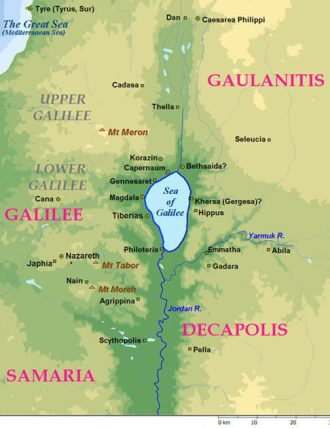
Sea of Galilee in New Testament times (GodsWordFirst)
Mark wrote Jesus “was going to pass them by.” This detail was omitted in Matthew 14:24-26 and John 6:18-20, written later, using Mark as a source. This is a strange detail, making the story more dreamlike, as with the Koranic tale of the Hoopoe and Solomon discussed above. Jesus just happens to be walking on the surface of the Sea of Galilee and would walk right on by a boat filled with his friends while they struggle with the waves and wind, yet say nothing to them? Some commentators hold that Matthew and John intentionally edited that out because it made no sense.
The simplest solution is that the Greek preposition ἐπὶ – “epi” is mistranslated in this story. It should not be “on;” but “by,” “around,” “near,” or “along.” If Jesus didn’t notice them it was because he was busily picking his way down the storm-tossed beach, likely deep in thought. Some writers suggest that someone, somewhere, some when (opinions differ) chose “on” because it added to a desired presentation of Jesus as more than human. [Chuck Almdale]
Additional Sources:
1. Meaning of the Glorious Koran, The. Tickthall, Mohammed Marmaduke. (No date) Mentor/New American Library, New York.
2. New English Bible with the Apocrypha, The, Oxford Study Edition. Sandmel, Samuel, Suggs, M. Jack, Tkacik, Arnold J.; eds. (1972) Oxford University Press, New York
3. Random House Dictionary of the English Language. Stein, Jess, Ed. (1967) Random House, New York
Sources with Links
[1] “Why Islam isn’t like other faiths,” Shadi Hamid. Los Angeles Times, 9-15-16. Author is a senior fellow at the Brookings Institution and the author of “Islamic Exceptionalism: How the Struggle Over Islam is Reshaping the World.”
[2] Pew Forum Research, “The World’s Muslims: Unity and Diversity.” Aug 8, 2012. Section “Core Beliefs,” paragraph two and graph “Quran is God’s Word,” based on research 2008-09 “Tolerance and Tension: Islam and Christianity in Sub-Saharan Africa.”
[3] Pew Forum Research, “Muslim Americans: No Signs of Growth in Alienation or Support for Extremism.” Aug 30, 2011. Section “Religious but not Dogmatic,” paragraph three and graph “American Muslims & Christians.”
Return To Top
Sunday Morning Bible Bird Study VIII:
Don’t Eat That Bird!
We now begin a look at the birds considered unclean and not to be eaten by the children of Israel.
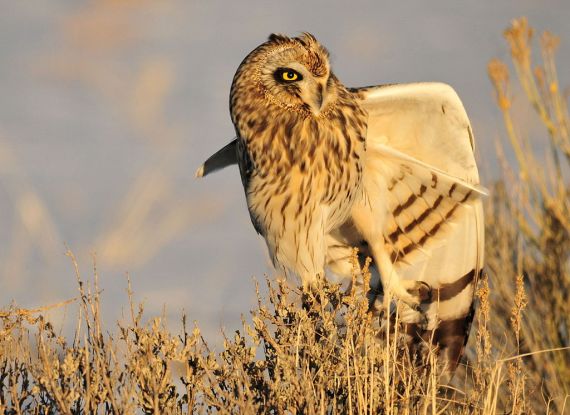
Short-eared Owl Asio flammeus – Seedskadee NWR, WY
(Tom Koerner – Wikimedia Commons)
These are the birds that you shall regard as vermin, and for this reason they shall not be eaten: the griffon-vulture, the black vulture, and the bearded vulture; the kite and every kind of falcon; every kind of crow, the desert-owl, the short-eared owl, the long-eared owl, and every kind of hawk; the tawny owl, the fisher-owl, and the screech-owl; the little owl, the horned owl, the osprey, the stork, every kind of cormorant, the hoopoe, and the bat.
Leviticus 11:13-19 New English Bible
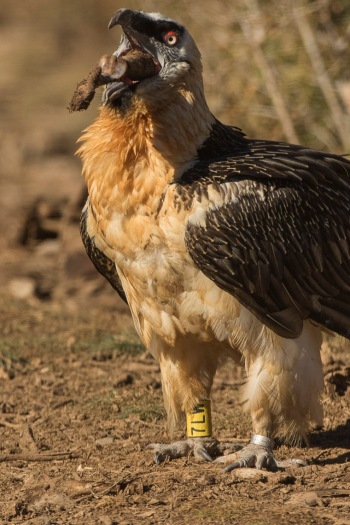
Bearded Vulture (or Lammergeier) Gypaetus barbatus scarfs down a big bone (Francesco Veronesi, Italy – Wikimedia Commons)
My first impression of this list is that I wouldn’t want to eat any of these birds myself. Some of their dietary habits are rather repugnant. If you are what you eat, I don’t want to eat them! Others I am quite fond of and – as with most people – I refrain from eating my friends. While the rationale, if any, behind these biblical dietary injunctions is not really well understood, and theologians and scholars have argued about them for millennia, it seems that these bird’s choices in cuisine are as good a reason as any for putting them off-limits. If something eats garbage, dung, or dead and rotting insect-infested meat, you might be wise to leave it alone.
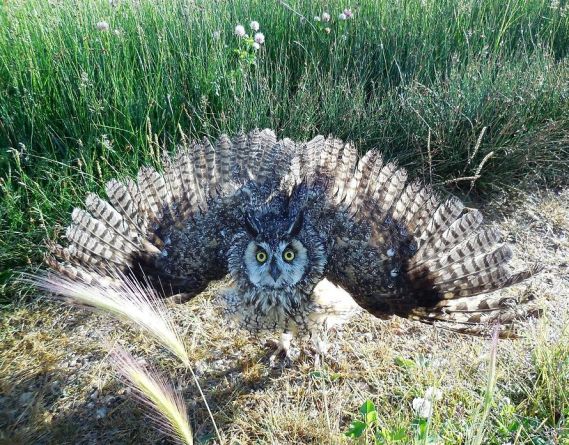
Long-eared Owl Asio otus, USFWS Mountain-Prairie
(Nicole Hornslein – Wikimedia Commons)
The second thing that strikes me about this list of forbidden flying food, is what an odd assortment of birds it is. In total, twenty species or families are named. The bat, of course, is not a bird (so we’ll ignore it.) It’s not that the infinite deity, or even
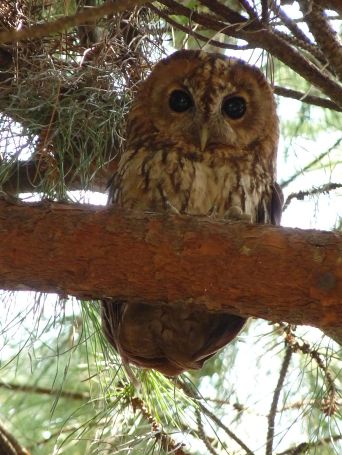
Tawny Owl Strix aluco; Beldibi, Marmaris Mugla, Turkey (Nottsexminer – Wikimedia Commons)
the ancient Israelites, goofed up and mistook it for a bird – no feathers, for starters – but that their word עוֹף oph meant “flying creatures,” excepting insects which were pestiferous and plentiful enough to warrant their own names.
Of the nineteen remaining named birds, eight are owls. As of October 1, 2016, there are 10,514 avian species in the world, of which 228 are owls, or 2.2% of the total. Yet owls comprise 42% of the deity’s Do Not Eat list. This seems peculiar. I can’t think of any owl I’d wish to eat; their eating habits are all pretty much the same; why didn’t the deity just say “every kind of owl” and be done with it, as was done with falcons, hawks and cormorants? Does this mean it’s OK to eat those owls not named? That doesn’t seem reasonable.
Ten owl species live in our target area of Israel and environs. In current phylogenetic order they are: Barn Owl Tyto tyto; European Scops-Owl Otus scops; Pallid Scops-Owl Otus brucei; Eurasian Eagle-Owl Bubo bubo; Brown Fish-Owl Ketupa zeylonensis; Little Owl Athene noctua; Tawny Owl Strix aluco; Desert Owl Strix hadorami; Long-eared Owl Asio otus; and Short-eared Owl Asio flammeus. Our Unclean Birds list totals eight. Assuming that the English names given in my bible translation are valid – a very big assumption – the Little, Tawny, Long-eared and Short-eared Owls match. Of seven species of Fish-Owl, the Brown is the only one in the area. The “horned” owl has to be Eagle Owl; it has large horns and is the largest owl in the area, impossible to overlook. The “screech” owl is likely the Scops-Owl, a small widespread owl closely related to screech owls; the European O. scops is widespread and common, whereas the range of the Pallid O. brucei is farther east, only occasionally reaching Israel. They are very similar in appearance.
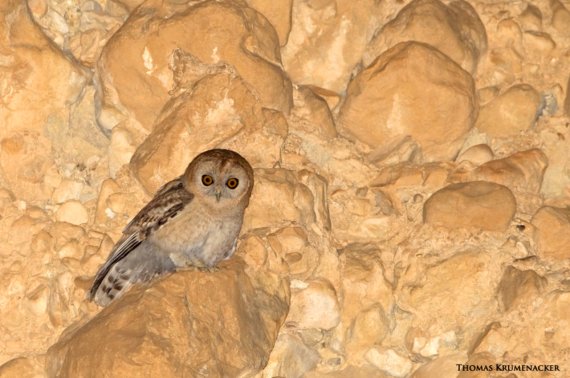
Desert Owl Strix hadorami, Israel
AKA Desert Tawny Owl, formerly known as Hume’s Owl, Strix butleri
(Thomas Krumenacker – Science News)
The “desert owl” is problematic, although there actually is a Desert Owl Strix hadorami, also called Desert Tawny Owl. Its predecessor species, Hume’s Owl Strix butleri, was split in 2015 when the widespread form was recognized as different from the Omani Owl, endemic to Oman. The widespread form became S. hadorami, the Omani form became Omani Owl, retaining S. butleri. However, because Desert Owl closely resembles Tawny Owl S. aluco, it’s likely the ancient Israelites saw them as the same bird. This leaves Barn Owl Tyto tyto – a scattered and widespread resident throughout the region – as the possible “desert” owl.
Barn Owls are relatively large, often noisy, nest and roost in both trees and human-build structures, and delight in devouring small rodents noxious to humans and their crops. It seems unlikely they would not be noticed.
If we accept the above analysis – taking Barn Owl as “desert” owl, and eliminating the Pallid Scops-Owl and Desert Owl as too similar, respectively, to European Scops-Owl and Tawny Owl, for ancient Israelites – who lacked binoculars – to distinguish, we are left with a total of eight owls in the area. Eight owls available, eight owls individually labeled “unclean.” Which returns us to the unanswerable question: why not just say “every kind of owl” and be done with it? The deity works in mysterious ways, apparently without an editor.
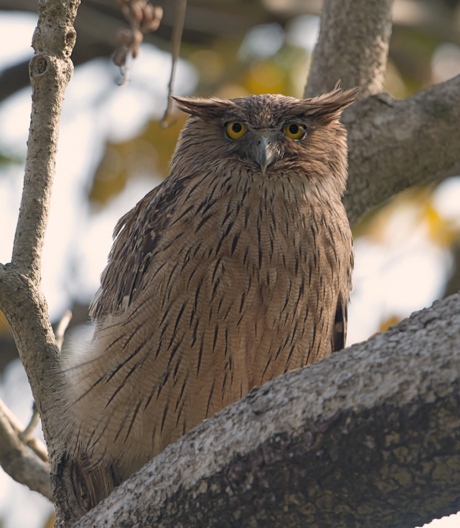
Brown Fish Owl Ketupa zeylonensis;
Corbett National Park, Uttarakhand, India
Their feet are specially adapted to catching slippery fish
(Koshy Kosny – Wikimedia Commons)
To single out owls like this as unclean is a bit unfair. This worldwide family of birds has a lot of charisma – even many non-birders admire and appreciate owls, and owls are very useful to humans. Except for the seven Old-World species of fishing-owls, they feed primarily on small rodents and large insects which in turn prey on our crops, infest our buildings, and carry diseases like bubonic plague. Because their extremely large night-adapted eyes are fixed immovably in the skull, they need to move their head to look around. As a result, they evolved the ability to rotate their head as much as 270 degrees to either side, for a total rotation of 540°. Barn Owls can hear a mouse rustling in the grass over 100 yards away. Because one ear hole is slightly higher on the skull than the other, Barn Owls can locate such faint sounds in three dimensions, and can find and seize that mouse in absolute pitch darkness. (Humans are good at locating sounds to either side (horizontal axis), but locate sounds on the vertical axis only with difficulty.) From thirty yards away, the Great Gray Owls of the far north can hear the movement of voles beneath two feet of snow. These are abilities unique in the world of birds.
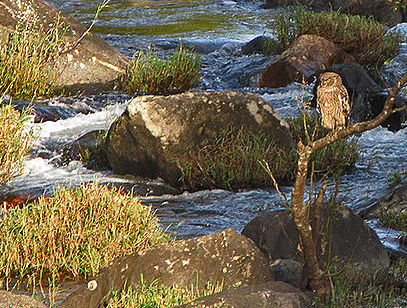
Brown Fish Owl Ketupa zeylonensis; Tamil Nadu, India
The “fisher” owl (D Momaya – Wikimedia Commons)
On the other hand, divine removal from humanity’s menu was, for Owls, fortuitous. It obviates the typical fate befalling animals we find edible: either eaten into extinction or enslaved to feed humanity. Perhaps the deity was really protecting a wonderful family of birds, rather than saving humans from possible illness. Now there’s a thought!
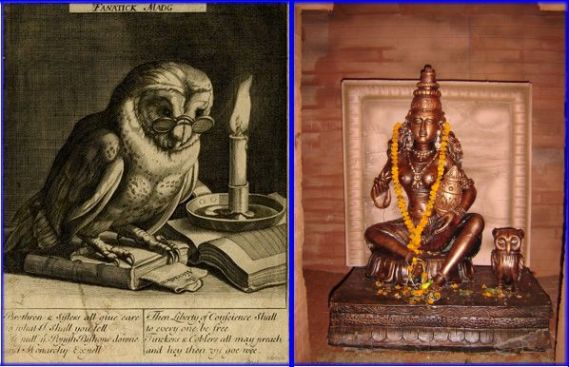
Fanatick Madg (British Museum) &
Hindu Goddess of fortune Lakshmi with her owl (Wikipedia)
Because most owls are nocturnal, they are often feared. Night is the time of evil spirits in many cultures, when ghosts, demons, and “things that go bump in the night” roam about, killing and devouring us, or infesting our bodies with their evil
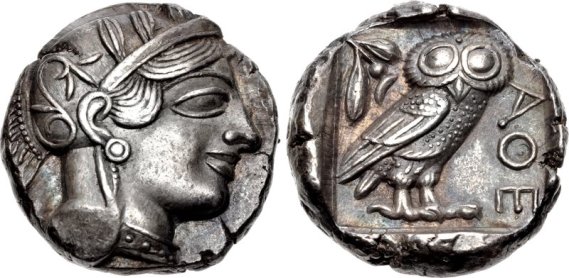
Athenian tetradrachm, 454-404 BCE; goddess Athena and her wisdom-owl who sees into the darkness of men’s souls
(Wikipedia – Classical Numismatic Group)
powers. Owls have been thought to be a witch’s demonic “familiar”, abettors in their nefarious deeds. Even today, there are people in America who believe a “hoot-owl” call to be an omen of death. Out in the country, particularly in the south, there is an owl calling
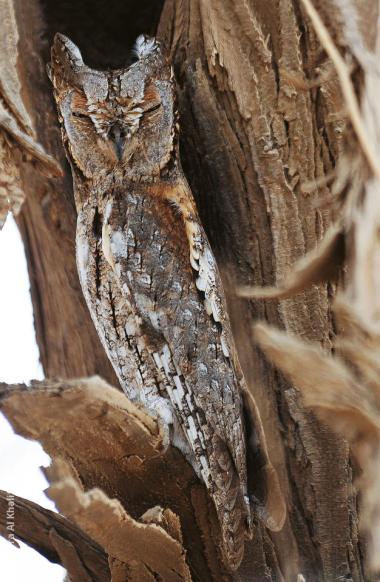
Eurasian Scops Owl Otus scops; Kuwait
The “screech” owl (Samera Al Kalifah – Kuwait Birds.org)
within earshot just about everywhere, throughout the year. Owls call, people die, but assuming that one causes or predicts the other is an example of the common logical fallacy post hoc ergo propter hoc (Latin – “after this, therefore because of this”).
God’s injunction against owls reminds me of a famous and mostly-true story about JBS Haldane, British biologist of the middle 20th century, which goes something like this:
Reverend Whoozit: Will you tell me, Professor Haldane, what your study of nature has taught you about the mind of God?
Dr. Haldane: Certainly. God is inordinately fond of beetles.

Three Little Owls Athene noctua, in a rain gutter; Warsaw, Poland
(Artur Mikolajewski – Wikimedia Commons)
Scientists now estimate that perhaps half of all the 10-30 million species of animal life on earth are beetles, so Haldane was by no means merely being flippant. Consider for a moment: if variety is the spice of life, and repetition is boring, what are we to make of 5-15 million members of the beetle family versus 10,500 of birds and less than 5000 species of mammals. Perhaps we can modify Haldane’s observation with the deity’s injunction, and say:
God is inordinately fond of beetles and abhorrent of owls.
But perhaps I’m overstating the case. It’s food for thought.
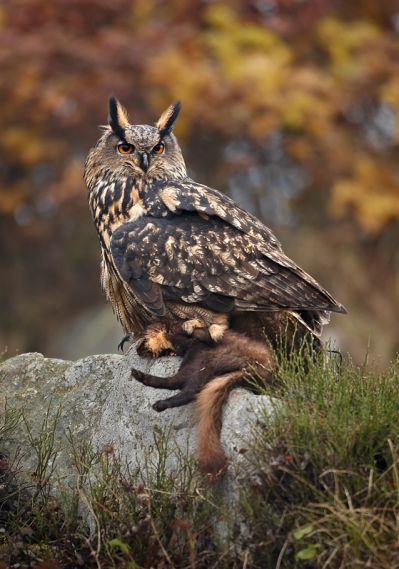
Eurasian Eagle Owl Bubo bubo – The “horned” owl
Zdarsle vrchy, Czechoslovakia
(Martin Mecnarowski – Wikimedia Commons)
Bible Factoid #8: Of “Of”
“Of” is another of those irritating prepositions with numerous senses. The Oxford English Dictionary (OED) entry for “of” covers six pages, with sixty-two senses grouped into seventeen branches. Although the phrase annoys a great many sincere and devout Christians, it is currently fashionable to speak of the Bible (combined Jewish and Christian scriptures) as the “Word of God,” as if God himself hoisted His mighty pen and inscribed the words in eternal ink. But with sixty-two possibilities, what does “of” really mean?
The phrase “word of God” appears forty-eight times in the Jewish and Christian scriptures. None of the authors of the eighty-one books comprising the Christian Bible would have used this phrase to refer to their own writings or those by another, or to a not-yet-existing collection of such works. At least, none did. They wrote about God, or what they felt God was saying to them, but lacked the impudence to suggest that God actually wrote the words they penned. Those who feel inspired by God – witness the mystics of all major religions – always insist how ineffable is the experience, how meager their ability to express it. Their writings are God-inspired, perhaps; God-written, no.

Two eternal questions: Who wrote the Bible or the Book of Love (The Monotones wrote #2:
Lyrics – Photo: Grub.ws)
In their various usages, “Word of God” refers to something spoken by a human about their deity, or a spiritual word “spoken” or “thought” by that deity, most often when it has entered into someone’s mind. For example:
But the word of God came unto Shemaiah the man of God, saying… 1 Kings 12:22
…as the people pressed upon him to hear the word of God… Luke 5:1
…and they spake the word of God with boldness… Acts 4:30
But the word of God grew and multiplied… Acts 12:24
Now when the apostles…heard that Samaria had received the word of God… Acts 8:14
…and his name is called The Word of God. Revelation 19:13
If “of” in “Word of God” carried the same sense as in “John of London” or “Duke of Earl,” then we would mean the “word” from “God” or the “word” that lives or resides in “God.” But consider this.
The King James Version of the Christian Bible was published in 1611, when English usage was significantly different than it is today. Then it was common to say something like, “You are returned from London. Have you brought any word of my brother?” In this sense, “of” means “concerning” or “about.”
The appropriate OED sense for this usage is:
Branch VIII: Indicating the subject-matter of thought, feeling or action, i.e. that about which it is exercised.
26. In sense: Concerning, about, with regard to, in reference to.
Some examples:
1542 Udall – Of these games is afore mentioned.
1590 Spenser – To sing of knights and ladies gentle.
1697 Dryden – The learned Leaches…shake their Head, desponding of their Art.
1859 Dickens – A Tale of Two Cities
2010 The Economist – Recession…[has] put paid to most thoughts of further EU enlargement.
The proper interpretation of “reading the word of God” is “reading about God,” or “reading words about God,” without the implication that God somehow wrote the words you are reading. Again: Inspired by , perhaps; written by, no. [Chuck Almdale]
Additional Sources:
1. Audubon Society Encyclopedia of North American Birds. Terres, John K. (1980) Alfred A. Knopf, New York. Pgs 664-673.
2. Birds of Europe. Mullarney, K., Svensson, L., Zetterström, D., Grant, P.J. (1999) Princeton University Press, Princeton, N.J. – Owls, Pgs 206-214.
3. New English Bible with the Apocrypha, The, Oxford Study Edition. Sandmel, Samuel, Suggs, M. Jack, Tkacik, Arnold J.; eds. (1976) Oxford University Press, New York
4. Oxford English Dictionary. (1971) Oxford University Press, New York
Links With Notes:
Tree of Life To navigate Tree Of Life, click binoculars icon in upper right corner, enter bird name and press “next hit” until you get to your bird.
Cornel Lab of Ornithology Clements Downloadable Checklist of Birds of the World, updated August, 2016.
BibleHub.com An invaluable tool. Almost a “one-stop-shopping” research site for the bible. Watch out for the occasional fundamentalist bias.
Return To Top
Sunday Morning Bible Bird Study IX:
Don’t Eat That Bird – Part 2:
The ground begins to shift beneath our feet
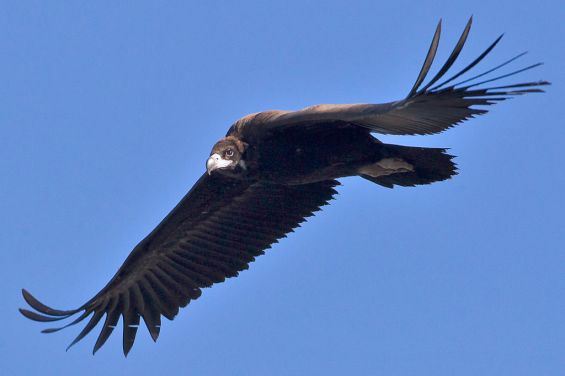
Eurasian Black Vulture or Cinerous Vulture Aegypius monarchus
(Juan Lacruz – Wikimedia Commons)
These are the birds that you shall regard as vermin, and for this reason they shall not be eaten: the griffon-vulture, the black vulture, and the bearded vulture; the kite and every kind of falcon; every kind of crow, the desert-owl, the short-eared owl, the long-eared owl, and every kind of hawk; the tawny owl, the fisher-owl, and the screech-owl; the little owl, the horned owl, the osprey, the stork, every kind of cormorant, the hoopoe, and the bat. Leviticus 11:13-19 New English Bible
Last time we looked at the owls and their noteworthy domination of this list, comprising eight of the nineteen listed birds, excluding the bat. This peculiar preponderance led me to check the footnotes in my New English Bible, where I found evidence for the translator(s) uncertainty, indicated by the following possible substitutions: eagle for griffon-vulture, ossifrage for bearded vulture, raven for crow, and heron for stork. These uncertainties are quite understandable to the experienced birder.
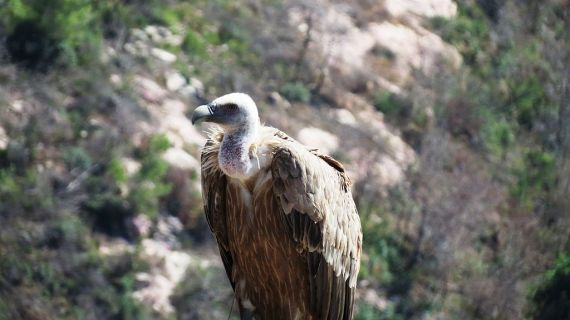
Juvenile Griffon Vulture Gyps fulvus, Haifa, Israel
(Avi Amiel – Wikimedia Commons)
The griffon-vulture, or Eurasian Vulture, or Eurasian Griffon as it is currently known, is superficially like an eagle. A very large carnivore, soaring on wide, flat wings, it is resident from northern India to Spain, including Palestine, where it nests in cliffside colonies. Many raptor species breeding in Eurasia, including Eurasian Griffons, migrate through Palestine to their wintering grounds in southern Egypt, Sudan, and across sub-Saharan Africa. [Israel is famous for springtime raptor migrations.] The Israelites would have been quite familiar with them. It’s not only translators who have a problem differentiating vultures from eagles, as the Wikipedia Commons title for the above Griffon Vulture photo is “An eagle near Haifa.” All Old-World vultures have a long, drooping neck, unlike any eagle, which have thick, short necks. This difference is quite obvious, even at great distances. [The short necks of the seven species of New World Vultures do not droop, one reason why they were recently classified into their own family, Cathartidae.] All vultures, with one exception, are exclusively carnivorous, eating only animals they have found already dead. (The exception is the Palm-nut Vulture of sub-Saharan Africa. Guess what it eats.) This habit is quite disgusting to most people. But consider this: when was the last time you ate a live animal? I prefer my food to have stopped thrashing about, at the very least, thank you.
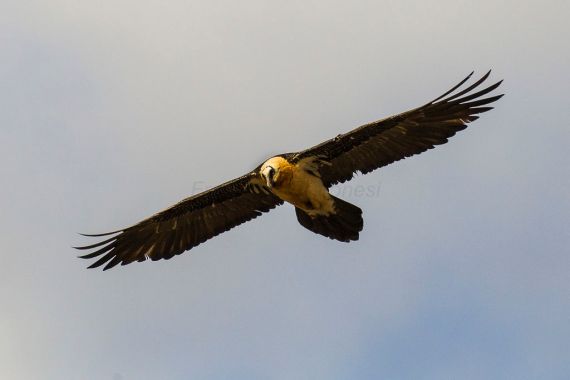
Bearded Vulture Gypaetus barbatus; Catalan, Pyrenees, Spain
(Francesco Veronesi – Wiki Commons)

Bearded Vulture (Ossifrage) Gypaetus barbatus, swallowing a big bone
(Francesco Veronesi – Wiki Commons)
Ossifrage (from Latin for “bone” + “break”is an archaic name for Bearded Vulture, also known as Lammergeier (German for “lamb vulture”). This unusual vulture ranges from South Africa to southern France to western China. For millennia, Tibetan and western Chinese “bonebreakers” relied upon vultures to eat the flesh of their corpses, and the “ossifrage” to carry away and devour the bones of their dead. In the Palestine area, they currently nest in Turkey, Jordan, Egypt and Arabia. They have the curious dining preference of carrying bones to great heights, dropping them on rocks, and then descending to eat both shattered bone and marrow. This seems like an odd way to get a meal, but they’re the only bird doing this, so they have the niche to themselves. At some unidentifiable time past, by the way, the fresh-fish-eating Osprey was confused with and misnamed for this bird. The name “Osprey” derives from “ossifrage.” Needless to say, Ospreys do not swallow large bones.

You need never be confused again
(Camara Miller – Highline Online)
Ravens are very closely related to crows, and share the genus Corvus. Indeed, ravens could be simply considered large crows, or crows small ravens. This genus has been very successful, and its 42 species have spread worldwide, excepting South and Central America, from its ancient Australasian origin. They are very intelligent and social, and a crow family may stay together many years. Omnivorous, they eat all kinds of plant and animal matter. They particularly love road kills and garbage. There are four species than likely lived in ancient Palestine, as discussed in lesson five: Jackdaw, Hooded Crow, Common Raven and Brown-necked Raven. The various jays, magpies and choughs, although also in the family Corvidae, are less likely to be confused with either raven or crow.
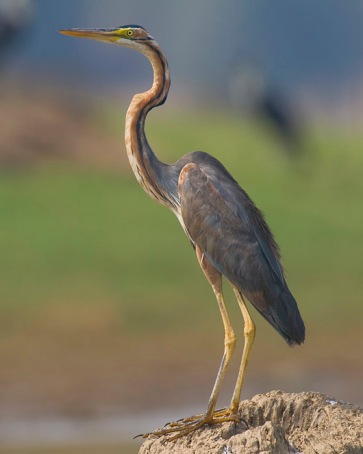
Purple Heron Ardea purpurea, Nagarhole NP, India (Yathin Krishnappa – Wiki Commons)
Herons are easily mistaken for storks, although they are only distantly related. They are an example of convergent evolution: similar living situations cause unrelated animals to evolve similar body styles and habits. Both are long-necked, long-legged wading birds. Of the 19 stork species only the Wood Stork lives in North America. The Black Stork and White Stork migrate through Palestine in spring and fall, but nest no closer than central Turkey. Storks eat many snails and other invertebrates, food items also forbidden to the Israelites. The White Stork is famous for nesting on chimneys and rooftops all across Europe. It was considered a sign of good fortune and especially good fertility, for a stork to nest on your rooftop; this gave rise to the popular image of the stork carrying a human baby in its bill. Herons are world-wide, and also eat many invertebrates, amphibians and other fare forbidden to the Israelites. In Palestine, herons are represented by Gray Heron (Ardea cinerea) Purple Heron (Ardea purpurea) and Black-crowned Night-Heron (Nycticorax nycticorax), the same species we have in America.
White Stork – Ciconia ciconia, with nesting material, Bingenheimer Reid, Germany (Christina Zientek) // Black Stork – Ciconia nigra (Marek Szczepanek) (Both from Wiki Commons)
But these small notations did not satisfy my curiosity. I decided to check a little further, and see how this passage might read in another translation of the Bible. What I found was pretty interesting, with far-reaching ramifications.
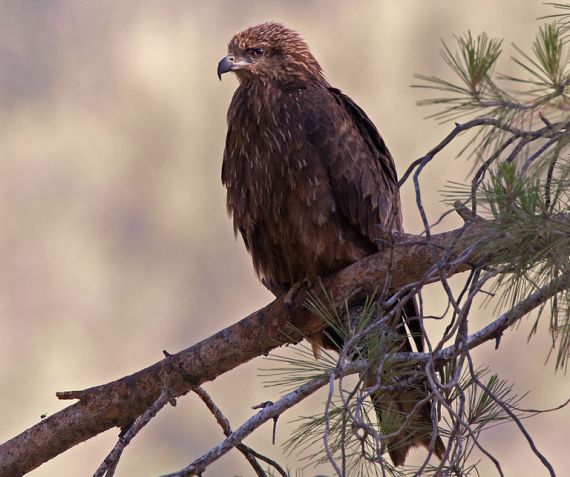
Black Kite Milvus migrans, Upper Galilee, Israel
(Artemy Voikhansky – Wiki Commons)
This is as good a time as any to cite, in passing, the verses immediately following those cited above. If you don’t understand why, check the picture below.
All teeming winged creatures that go on four legs shall be vermin to you, except those which have legs jointed above their feet for leaping on the ground. Of these you may eat every kind of great locust, every kind of long-headed locust, every kind of green locust, and every king of desert locust. Every other teeming winged creature that has four legs you shall regard as vermin… Leviticus 11:20-23
I hope you didn’t need me to point out that “teeming winged creatures,” aka insects, have six legs, not four, but if you did, there it is. The deity’s editor slips up again. Pegasus and a few griffons are the only creatures I know of with wings and four legs, and they don’t exist anyway.
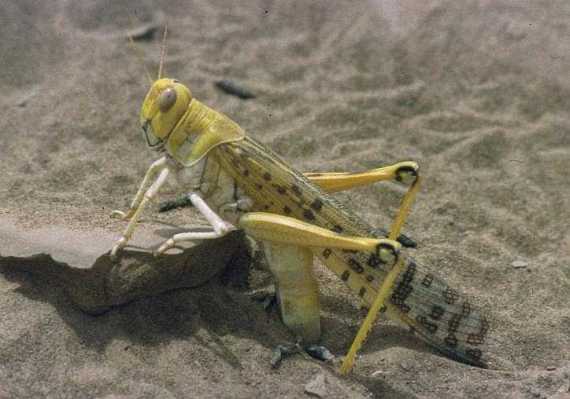
To get you ready for our next lesson, here’s the translation from the Masoretic Text. Compare it to the version from the New English Bible, cited at the top.
And these ye shall have in detestation among the fowls; they shall not be eaten, they are a detestable thing; the great vulture, and the bearded vulture, and the ospray; and the kite, and the falcon after its kinds; every raven after its kinds; and the ostrich, and the night-hawk, and the sea-mew, and the hawk after its kinds; and the little owl, and the cormorant, and the great owl; and the horned owl, and the pelican, and the carrion-vulture; and the stork, and the heron after its kinds, and the hoopoe, and the bat. Leviticus 10:13-19
Bible Factoid #9 – Seeing “Red”
Did Moses lead the Children of Israel across a sea of red or a sea of reed? This argument has long raged well out of sight of the average Christian.

Exodus 13:18, original 1611 King James Version (OriginalBibles pg. 149)
The Changing Translation of ס֜וּף “sup” as “reed” or “red”
The word ס֜וּף “sup” (or “suph”) occurs 28 times in the Jewish scriptures. The first book, Genesis, does not use it, instead using the adjective אַדְמוֹנִ֔י ad-mo-nee, translated as “red” or “ruddy,” three times, first in Genesis 25:25 in reference to Abraham’s grandson Esau.
ס֜וּף sup first appears in reference to baby Moses, floating in his tiny boat among the reeds.
So she got a rush basket for him [baby Moses], made it watertight with clay and tar, laid him in it, and put it among the reeds (בַּסּ֖וּף – bas-sup “in/among the reeds”) by the banks of the Nile. Exodus 2:3 NEB
She [Pharoh’s daughter] noticed the basket among the reeds (הַסּ֔וּף – has-sup “the reeds”) and sent her slave-girl for it. Exo 2:5 NEB
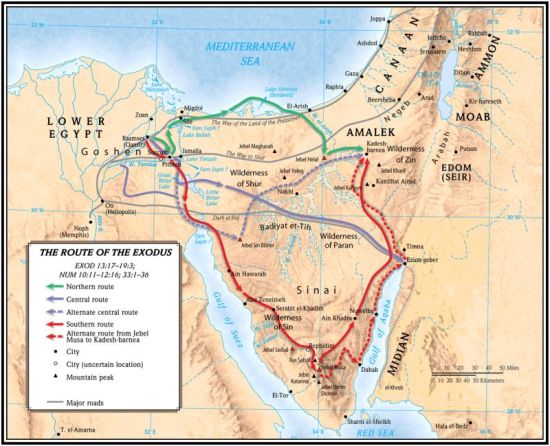
Egypt, Sinai, Gulfs of Suez and Aqaba, north end of the Red Sea (AllFaith.com)
At Exodus 10:19, the first mention of the “sea of red,” the translation changes.
The Lord changed the wind into a westerly gale, which carried the locusts away and swept them into the Red Sea (יָ֣מָּה – yah-mah “into the sea” + סּ֑וּף – sup “”red”). Exo 10:19 NEB
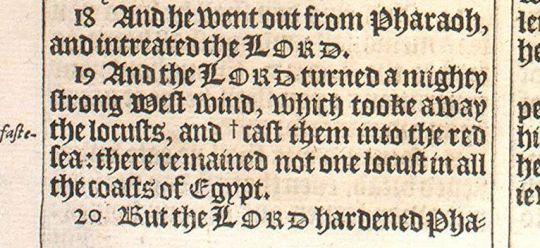
Exodus 10:19, original 1611 King James Version (OriginalBibles pg. 145)
The Red Sea is next mentioned in connection to the Israelites fleeing Egypt, crossing the water and the drowning of Pharaoh’s army.
So God made them go round by way of the wilderness towards the Red Sea (יַם־ – yam “of the sea” + ס֑וּף sup “red”); and the fifth generation of Israelites departed from Egypt. Exo 13:18 New English Bible (NEB 1976)
The chariots of Pharaoh and his army he has cast into the sea; the flower of his officers are engulfed in the Red Sea (בְיַם־ – be-yam “sea” + סֽוּף׃ – sup “in the red”). The watery abyss has covered them, they sank into the depths like a stone. Exo 15:4-5 (NEB)
NEB footnotes Exo 13:18: “Red Sea: literally ‘Sea of Reeds,’ and hence a shallow papyrus marsh on the border of Egypt. The Red Sea is the name of the Gulf of Elath, much further east.” ff. pg 69. [I’m not sure the Elath part is correct. Elath is now Eilat, the city at the north end of the Gulf of Aqaba, the northeastern extension of the Red Sea which borders the east coast of the Sinai Peninsula. The Red Sea’s northwestern extension, the Gulf of Suez, lies between mainland Egypt and the Sinai west coast. Unfortunately, the NEB gives no further explanation.]
From this point through Jeremiah 49:21, whenever סּ֑וּף – sup modifies יַם־ – yam “sea,” it is translated as “red.”
The very last use of ס֔וּף – sup defines it as “weeds,” far closer to “reed” than to “red” in meaning:
The water about me rose up to my neck; the ocean was closing over me. Weeds (ס֖וּף – sup “the weeds”) twined about my head in the troughs of the mountains;… Jonah 2:5

Suez Canal, Great Bitter Lake midway, Gulf of Suez at bottom (Bible Journey)
Summarizing the ס֔וּף – sup translation problem:
1. ס֔וּף – sup occurs twenty-eight times, always classified as a noun; in the twenty-four occurrences where it modifies יַם־ – yam“sea” it is translated as “red.”
2. When it does not modify יַם־ – yam“sea,” it is translated as “reeds” (Exo 2:3 & Exo 2:5); “reeds,” “rushes” or “flags;” (Isaiah 19:6), or “weeds” Jon 2:5)
3. If translation erred – intentionally or unintentionally – at the first usage of “red,” (Exo 10:19), probability is high that in all subsequent usage in the same context, “the __ sea,” would be similarly mistranslated.
4. Scholars’ commentaries on these verses usually indicate that “reed” or “weed” is correct, not “red”: Exo 2:3, Exo 10:19, Exo 13:18.
The Red Sea
Egypt’s current capital, Cairo, is ninety miles from the Gulf of Suez. Thebes, the capital around 1300 BCE, was one hundred miles from the Red Sea. That’s a very long way for locusts to be blown, as Exo 10:19 claims, using the first translation of ס֔וּף – sup as “red.” Crops were

Great Bitter Lake & Suez Canal; Ismalia (city) at north end of lake (Bible Journey)
grown primarily in the fertile alluvial soil of the Nile delta; the ancient “store-cities” of Pithom and Per-Rameses built by the Israelites (Exo 1:11) were nearby. From either Pithom (some say Tell el-Maskhusa, nine miles west of Ismaliya on the Suez Canal) or Per-Rameses (Qantir), it is thirty miles to the large lakes now bisected by the Suez Canal. Scattered lakes and ponds abound throughout the area. These distances are far more reasonable for the blowing of locusts. The fastest route to and through the Sinai would be through this area, and opportunities would abound for losing potential pursuers among the marshlands, lakes and wadis.

Papyrus on the Nile (Bible Land Pictures – Zev Radovan)
In ancient Egypt, papyrus (גֹּ֔מֶא – go-me) (reeds) were abundant along the Nile and in the delta, and harvested for both domestic and export use. People can travel and avoid detection among beds of towering papyrus. Water levels in shallow marshes can fluctuate, strong winds can raise waves. Whether one’s neighborhood consists of buildings, fences and alleys, or of wadis, marshes and reeds, there are always “locals” who know the fast and surreptitious routes. Moses, living east of Egypt, and his brother Aaron, living within Egypt, may have been such people. They could lead people on foot safely, quickly and secretly through areas which would mire horses and wheeled vehicles. Moses knew the Sinai – the water holes, the edible plants, when the Common Quail came through in the millions. In this scenario, Moses is less the God-struck prophet freeing his people and binding them to God, than the wily Mexican-style coyote, leading people, perhaps repeatedly, across a border to “the promised land,” and a better life of freedom and prosperity.
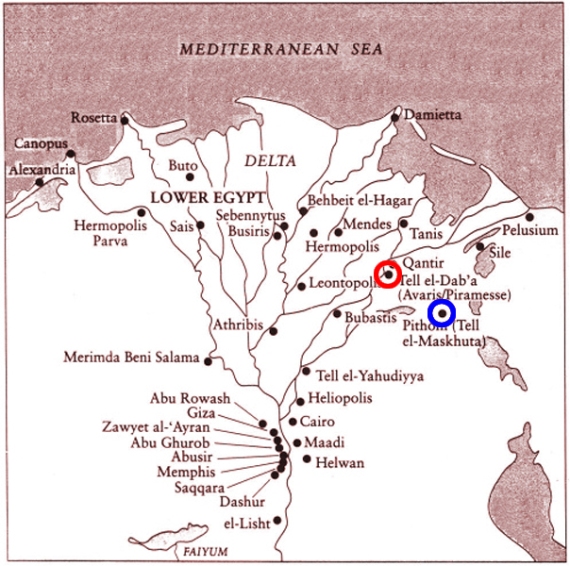
Nile Delta, ancient Egypt – Per-Rameses circled red, Pithom circled blue
(Ancient Near East – Just the Facts)
Whether “Israelites” ever lived in Egypt, fled Egypt for elsewhere, or were pursued by troops cannot be settled here. But the “Sea of Red” is too wide (150 miles) to be crossed in a few days, let alone a few hours, and too far from the hard-labor slaves located in the delta. But a “sea of reeds” near the delta fits what few details Exodus gives without forcing us to swallow unlikely translations which necessitate miracles.
The Septuagint (LXX)
According to numerous sources, such as Bible Archeology:
The “Red Sea” phrase came into the account with the third century BC translation of the Old Testament into Greek. Called the Septuagint (abbreviated as LXX), its translators made yam suph (“Sea of Reeds”) into [ἐρυθρὰν θάλασσαν] eruthrá thálassē (“Red Sea”). The Latin Vulgate followed their lead with mari Rubro (“Red Sea”) and most English versions continued that tradition.
The number of websites discussing this problem are legion. The reasons to choose “reed” seem rational and reasonable. The reasons to choose “red” are based on tradition and a faith-based need for miracles. [Chuck Almdale]
Additional sites arguing for “reed”: Additional sites arguing for “red”:
Christianity – Stack Exchange Orthodox Union
Ancient Near East – Just the Facts Religion Today
The Bible Journey United Church of God – Beyond Today
Additional Sources
1. Birds of Europe. Mullarney, K., Svensson, L., Zetterström, D., Grant, P.J. (1999) Princeton University Press, Princeton, N.J.
2. Dictionary of American Bird Names. Choate, Ernest A. (1985) Harvard Common Press, Boston.
3. Handbook of Birds of the World (HBW), Vol. 2. del Hoyo, J., Elliott, A. & Sargatal, J. eds. (1994) Lynx Edicions, Barcelona. Vultures – Pgs 125-129.
4. Holy Scriptures: According to the Masoretic Text. (1955) The Jewish Publication Society of America. Philadelphia.
5. New English Bible with the Apocrypha, The: Oxford Study Edition. Sandmel, Samuel, Suggs, M. Jack, Tkacik, Arnold J.; eds. (1976) Oxford University Press, New York
Links With Notes:
Tree of Life To navigate Tree Of Life, click binoculars icon in upper right corner, enter bird name and press “next hit” until you get to your bird.
BibleHub.com An invaluable tool. Almost a “one-stop-shopping” bible research site.
BibleStudyTools.com A very useful site.
Return To Top
Sunday Morning Bible Bird Study X:
Don’t Eat That Bird! – The Last Bite:
The Problems of Translation
In our last lesson – Don’t Eat That Bird! Part 2 – we touched upon the translation uncertainty of the “unclean bird” names found in Leviticus 11:13-19. We now look farther into that uncertainty, and contemplate the ramifications of what we find.
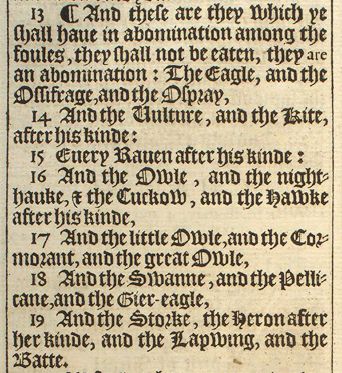
Leviticus 11:13-19 Original King James Version facsimile
The Unclean Birds chart below lists the Hebrew names and pronunciations, the number of times each name occurs anywhere in the Jewish scriptures, English names chosen by the translators of four English versions, and the names from the similar – but not identical – list in Deuteronomy 14:12-18. The twenty-one names listed in Deuteronomy are in a different sequence from that of Leviticus; I put them into the Leviticus sequence to simplify comparison.
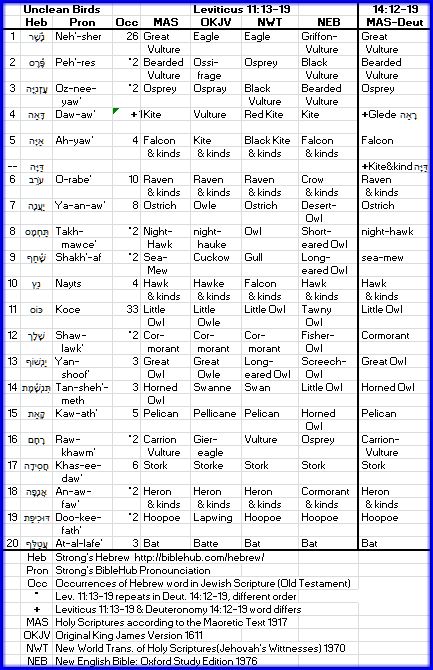
Unclean bird comparison: four versions from Leviticus, one from Deuteronomy.
If we compare the versions shown above, we find such “equivalences” as:
(7) Ya-an-aw`: ostrich, owl, desert owl
(9) Shakh`-af: sea-mew, cuckoo, gull, long-eared owl
(14) Tan-sheh`-meth: horned owl, swan, little owl
(15) Kaw-ath`: pelican, horned owl
(16) Raw-khawm`: carrion-vulture, gier-eagle, vulture, osprey
It should be obvious that no sane human actually confused an ostrich for an owl, or a horned owl for a swan. The problem originates elsewhere.
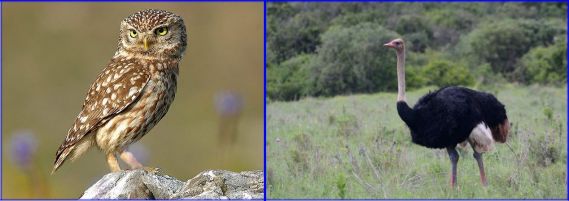
Which is which? Too similar to tell? (Both Wiki Commons)
Little Owl (Trebol-a 3-21-10)
Ostrich, Addo Nat. Elephant Park, Saudi Arabia (Kore 11-21-13)
The chart above shows forty possible English translations for the twenty Hebrew names of our unclean birds, and that’s from only four English translations. [I eliminated obvious equivalences as: Bearded Vulture and Ossifrage, Osprey and Ospray, hawk and hauke.] We also find the same English name in different locations in the four Leviticus lists. For example, birds 2 and 3 seem to have interchangeable translations, even though the Hebrew words are quite different. The twenty Hebrew names in Leviticus don’t shift positions, but their English translations certainly do. If we examined the dozens of bible translations, we would find even more translation variances for these twenty Hebrew words.
Here’s the cause of the problem. The occurrence column shows how many times each word occurs in the bible. For example, Daw-aw` דָּאָה (note the small diacritical dot inside the last character) “kite” occurs only once (replaced in the Deuteronomy list by רָאָה (no dot) – raw-aw` “glede” and/or דַּיָּה – dah-yaw` “kite”). [Ancient Hebrew had no vowels. As centuries passed and original pronunciation forgotten, diacritical marks were added to the letters, and comments on pronunciation made in the margins. Needless to say, despite extreme efforts to maintain accuracy, errors and changes occurred.] These three words look and sound similar and apparently all refer to the very same bird, so they may constitute ancient biblical typographical errors. The most common of the twenty names, Koce “Little Owl,” has only thirty-three occurrences; compared to the most common words which occur thousands of times, that’s not many.
In short, it’s very difficult to know what rarely used words really mean, especially when their usage is always in the same context.

Two of the many kinds of “glede” (both WikiCommons)
Red Kite – Gredos Mtns, Avilo, Spain (Arturo de Frias Marques 12-8-12)
Black Kite – Iwata, Shizuoka, Japan (Nubobo 1-11-14)
New Unclean Birds
If you guessed that “glede” has something to do with “glide,” you are correct. Oxford English Dictionary (OED) traces it to Old English “gleda;” usage citations range from 725 CE to 1884 CE. The name, usually applied to the Red Kite Milvus regalis [now M. milvus], is “also locally applied to other birds of prey, as the buzzard, osprey and peregrine falcon.” Unfortunately for British biblical translators, Red Kite, common in Western Europe, does not occur at all in Palestine. However, Black Kite M. migrans migrates through Palestine, with a small wintering population in northern Israel. Closely related, these two species occasionally interbreed, and were likely difficult to differentiate in olden days. With “glede,” translators doubled the confusion by choosing a name applied to at least five species as translation for a Hebrew name of uncertain meaning.

Gulls: Left to Right (all Wiki Commons)
Little Ekaterina Chernetsova, 5-15-14, St. Petersburg, Russia
Black-headed Barak Baram, Israel, Feb. 2010
White-eyed Alexander Vasenin, Red Sea, 5-3-13
The OED gives citations from 1430-1890 CE for “Sea-mew,” known to us as Larus canus, the Mew or Common Gull. “Mew” is the Old English name for the bird, referring to the plaintive cry of most gull species, and this one in particular. Eight gull species regularly appear in Palestine: Slender-billed, Black-headed, Little, Mediterranean, Pallas’s (aka Great Black-headed), Audouin’s, Mew, Armenian (previously sub-species of Yellow-legged) and Lesser Black-backed. Two additional species – Sooty and White-eyed Gulls – are Red Sea breeders, wandering as far north as Eilat. The smallest species, Little (L 9-11″, WS 24-27″) is about 40% the size of the largest, Pallas’s (L 23-26″ WS 57-64″). Gulls are found on the coast as well as inland throughout the Jordan Rift Valley. The unclean bird list didn’t say “the gull after his kind,” so either they thought they were all one “kind”, or שָׁ֫חַף – shakh`-af was not a gull at all.
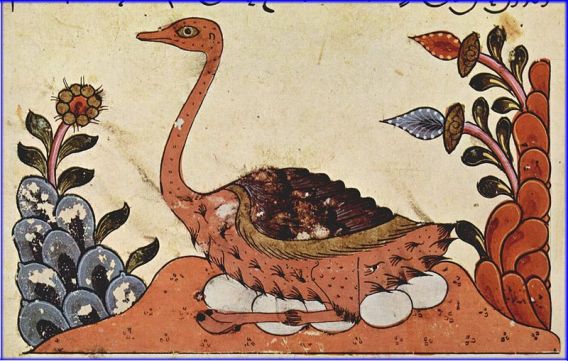
Arabian Ostrich, from The Book of the Animals by al-Jahiz, Syria, 14th Century
(Wiki Commons)
Ostriches Struthio camelus no longer occur outside of Africa; the Arabian Ostrich S.c.syriacus race was hunted into extinction by 1966. Although they were popular meals for Romans, the Israelites considered them both unclean and “heartless” (Lamentations 4:3), the latter because they leave their eggs unattended as their thick shells are sufficient protection from predators. Ostriches eat mostly grasses, seeds, leaves and succulent plants, plus some insects and lizards, so I can’t see why they would be unclean. It must have been hard for the Israelites to pass up eating a ten-foot-high, two hundred and fifty pound bird, large enough to feed a family for many days.
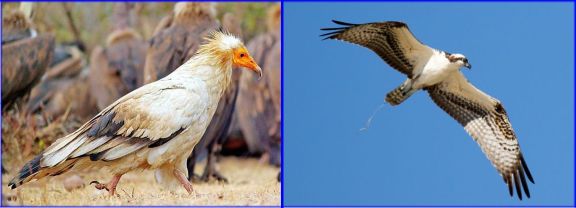
Egyptian Vulture – Chatarpur, India (Arindam Aditya Wiki Commons)
Osprey at Malibu Lagoon – another possible Gier-eagle (Randy Ehler 9-26-16)
There are yet more variations. Gier-eagle, by most accounts, refers to the Egyptian Vulture Neophron percnopterus, an important carrion-eater ranging from Cape Verde Islands eastward to Bangladesh. The cuckow, or cuckoo, is the Common Cuckoo, Cuculus canorus, [link includes call] beloved bird of Swiss clock-makers, and widespread across Europe and around the Mediterranean.
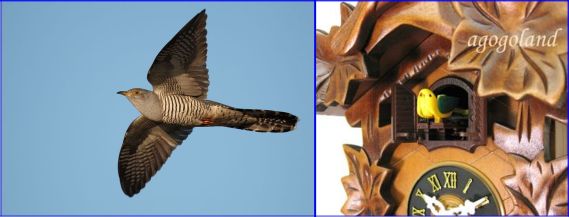
Common Cuckoo (Chris Romeiks, Vogelartinfo 5-1-10 Wiki Commons)
Clock Cuckoo who looks more like an overstuffed canary (Popscreen)
The Night-hawk is almost surely the European Nightjar Caprimulgus europaeus, also widespread across Europe and the Mediterranean, dining nightly on any flying insect. Other possibilities are Egyptian Nightjar and now very scarce Nubian Nightjar, both of which barely reach Palestine. The swanne seems out-of place: none breed in Palestine and the current population of wintering Mute Swans Cygnus olor in the area is exceedingly small. Perhaps the few mollusks they eat made them unclean, but I think it a misinterpretation; תִּנְשָׁ֫מֶת – tan-sheh’-meth is likely an owl, perhaps the easily confused (I’m joking) Horned or Little Owl some translators suggest.
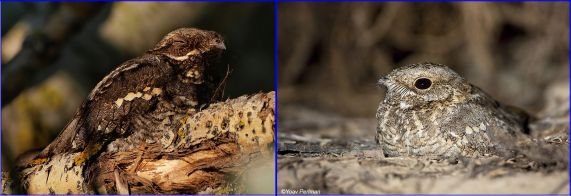
European Nightjar תחמס אירופי (Jenny Th; 5-27-09 Wiki Commons)
Nubian Nightjar תחמס נובי – Neot Hakikar, Israel (Yoav Perlman Mar’09)
Unless you like fish – and the Israelites and later Jews ate fish – you probably wouldn’t want to eat a pelican קָאָת – kaw-ath’ as that’s all they eat. Mostly skin, feather and bone – unappetizing, certainly, but unclean? I don’t see why. Great White Pelican Pelecanus onocrotalus (not our American White Pelican Pelecanus erythrorhynchos) migrates through Palestine and a small population winters in northern Israel. The larger Dalmatian Pelican Pelecanus crispus once numbered into the millions, but is now rare and still dwindling. They breed around the Black and Caspian Seas, wander widely post-breeding, and maintain a wintering population in Lebanon and northern Israel. They were likely very common in Palestine in biblical times.
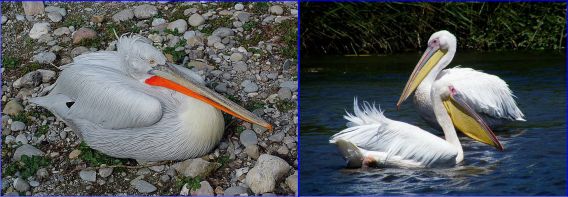
Pelicans available in Israel (both Wiki Commons)
Dalmatian Pelican (Marcel Burkhard)
Great White Pelican – Liesbeek River, Cape Town, SA (Andrew Massyn)
Similarly, the cormorant שָׁלָך – shaw-lawk’ is piscivorous; if you are what you eat, a cormorant must taste like a fish. They are, however, quite messy in their nesting habits, as are pelicans, and anyone might be reluctant to eat a bird that seems to wallow in its own excrement. In Palestine, they come in three flavors: Great Cormorant Phalacrocorax carbo, European Shag P. aristotelis, and Pygmy Cormorant Microcarbo pygmeus. All three winter in the vicinity of Palestine; the Pygmy is resident year-round.

Cormorants on hand in Israel (all Wiki Commons)
Great Cormorant – Hyogo, Japan (Miya 10-28-05)
Pygmy Cormorant – Hortobagy, Hungary (Martin Mecnarowski 6-18-10)
European Shag – Brownsea Island, UK (Ian Kirk 2-23-13)
I don’t have data to support this conjecture, but it seems that among carnivorous mammals (including humans) it’s a general rule that – except for eating fish – they prefer eating herbivores, but will eat omnivores when necessary. Carnivores sometimes kill carnivores to eliminate competition, but they don’t seem to eat them. Other than dogs (and fish), I can’t think of any carnivore that humans willingly eat. It doesn’t take much imagination to see that this preference would easily extend to the eating of birds.
Final Comment on Bible Bird Study Lessons I through X
The genesis of these essays began about fifteen years ago, when I wrote a series of six installments of “Birds in the Bible” for the newsletter of the church I attended. In that situation, all the readers were Christians and none were birders. I suspect the current situation is almost the opposite: very many birders and very few practicing Christians. The content of the old pieces constitute about 5% of the new.
At the beginning of lesson one, I wrote “Whatever one may think of the bible, it was inarguably written long ago by humans not significantly different than us, who wrote about what they knew and what they imagined, just as we do today.” Everything that followed is my support for that statement. Humans wrote the books for human reasons. These ten “lessons” were a phenomenological exercise in which we “bracketed” – suspended judgment about a phenomenon – in this case the bible – in order to analyze the experience. The bible is a phenomenon – it inarguable exists – but whether any of what it says is true is another matter, not under our investigation here. By incorporating what humans have learned about birds over the intervening millennia since the bible books were written, we found that sometimes the biblical writers sufficiently understood a bird’s behavior to reasonably incorporate it into their narrative. But sometimes not, which inevitably led us into textual analysis, where we found that in some cases it is as yet impossible to determine what the original words – as they have come down to us – actually meant. At the very least, we learned something about the birds that were out and about in those days in that region, and about those who observed them.
Bible Factoid #10 – Rare Words in the Bible
The Jewish scriptures have 8,674 different Hebrew root words (ignoring the addition of letters to change the case – “crow,” “crows,” “the crows,” “all the crows”). Four hundred(1) (4.6%) of these words are used only once. There are undoubtedly more words that occur only twice, and even more that occur only three times, far too few for certainty of meaning. In the Greek New Testament, there are 5,624 different words, of which 1,934 are used only once, or a whopping 34.4%. [On the other hand, the twenty-seven most common Greek NT root words constitute more than 50% of the 138,000 total GNT words.] The New Testament (NT) was written in Koine Greek, different from classical Greek. Some Koine words do not occur at all in classical Greek texts. How then, can we be certain of the intended meaning of such rare words? How can we feel confident that English translations of these ancient books are accurate, when the translators who actually know and read these ancient languages are literally using an educated guess as to the meaning of many of the words?
The short answer is: we can’t. I think that translations are as good as translators can make them. Although there are instances of intentional textual changes – Mark 16:9-20 is widely held to be a later addition – most variations are accidents. The number of unintended copying errors made during the early centuries, when scribes and monks copied scriptures by candlelight, are still beyond count. A single-letter copying error creates a new “version” of the bible. Bart Ehrman, in Misquoting Jesus, estimates there are between 200,000 and 400,000 such “versions” of the New Testament.
The number of translation differences we see in the list of twenty unclean birds is a peek through the door, for both birder and biblical neophyte, at the difficulties encountered when one attempts to know what the bible really says. We’ll take one more peek, this time with a famous and controversial phrase from what is probably the best-known passage in the New Testament, the Lord’s Prayer (Matthew 6:9-12 and Luke 11:2-4), found in Matthew 6:11 and Luke 11:3.

Matthew 6:11 interlinear translation (BibleHub)
The word ἐπιούσιον – epiousion, translated as “daily” as in “daily bread,” occurs only twice in the entire NT, both times in the context of the “Lord’s Prayer,” and occurs nowhere else in the entire body of Greek writing prior to the NT. This single context makes accurate translation impossible, just as with the names of the unclean birds. New English Bible says “daily bread,” but footnotes it with “or our bread for the morrow.” Oxford Companion to the Bible has “the bread we need for tomorrow,” adding as interpretation that we should concern ourselves with one day’s ration of food and leave the rest to God. An interpretation I learned in church was, “give us today the same spiritual food we will receive in our (eternal) future,” or shorter, “feed today our eternal souls.” This site gives five interpretations. Methodist minister Adam Clarke (1769-1832) had an interesting explanation: Travelers in the east ate the preceding evening’s leftovers for breakfast. The source of the next evening meal was unknown, so they must rely on God’s providence.

Pewter Tray Dish (Vintage Cantrell Collection)
But the word ἐπιούσιον – epiousion, is just too rare for certainty, and the intended meaning is probably lost forever. This critically important and best known passage in all of Christian literature is afflicted with the same ambiguity we found in our list of unclean birds, caused by the uncertainty in meaning of these ancient, rare words. This provides no comfort for those who demand biblical inerrancy, who cannot abide uncertainty. But for those who can tolerate uncertainty – and really, who can be 100% certain we will even live into the next minute – and whose faith has flexibility, it’s merely a minor bump in the road.
Final Note on the Bible Factoids
The factoids started as an afterthought, and weren’t called factoids until #4 was written, at which point I went back and renamed them. After the lesson on the doves and flood was posted, I recalled that few people know of the much older flood narration in the Epic of Gilgamesh, and thought it deserved a mention. The other factoids were topics I had found surprising and interesting during my own study of the bible, many years ago. I was still curious about several of the topics, and writing the factoids gave me the impetus to learn more, especially the evolution of Jesus’s name, the two bar-Abbas’, the Reed Sea, On “On,” and “daily” bread. Of “Of” was a special case – it’s something which had bothered me for decades; now I feel better. I had several other factoids written, but ran out of birds to run them with. I consider such factoids to be anomalies, peculiar items that don’t fit into the ordinary conversation on biblical matters.
Thomans Kuhn’s book, The Structure of Scientific Revolutions, was itself a scientific revolution, critically important in the history of the last century. By creating the concept of “paradigm shifts,” it thereby became its own paradigm shift. “Normal science” functions to fill gaps in our current model (viewpoints, theories, worldview) of reality. Inevitably, anomalies – events unexplainable within the current model – begin to appear. Such anomalies proliferate, forcing many to acknowledge the model as insufficient. Eventually a new model appears which explains the anomalies, and the process begins anew. I see religion in general and Biblical (and Koranic) studies in particular as models of reality currently riddled with anomalies. The revolution in biblical textual analysis began in the 19th century, yet is nowhere near finished. I can’t see that a similar process has even begun on the Koran. As long as the majority of people continue to view these texts as untouchable, sacrosanct, beyond criticism, we will remain trapped within these ancient models, which even now creak and crumble. These texts are culturally foundational texts, created by the amazing minds of humans; to treat them as deity-created diminishes both deity and human alike.
[Chuck Almdale]
Additional Sources:
1. Birds of Europe. Mullarney, K., Svensson, L., Zetterström, D., Grant, P.J. (1999) Princeton University Press, Princeton, N.J.
2. Dictionary of American Bird Names. Choate, Ernest A. (1985) Harvard Common Press, Boston.
3. Handbook of Birds of the World (HBW), Vol. 1. del Hoyo, J., Elliott, A. & Sargatal, J. eds. (1992) Lynx Edicions, Barcelona. Ostrich – Pg 83.
4. Handbook of Birds of the World (HBW), Vol. 2. del Hoyo, J., Elliott, A. & Sargatal, J. eds. (1994) Lynx Edicions, Barcelona. Vultures – Pgs 125-129.
5. Holy Scriptures: According to the Masoretic Text. (1955) The Jewish Publication Society of America. Philadelphia. [A 1917 translation]
6. Misquoting Jesus. Ehrman, Bart D. (2005) Harper Collins, San Francisco, Ca. Pg 89.
7. New English Bible with the Apocrypha, The: Oxford Study Edition. Sandmel, Samuel, Suggs, M. Jack, Tkacik, Arnold J.; eds. (1976) Oxford University Press, New York.
8. New World Translation of the Holy Scriptures. (1961) Watchtower Bible and Tract Society of New York, Inc. New York.
9. Oxford Companion to the Bible. Metzger, Bruce M. & Coogan, Michael D. (1993) Oxford University Press, New York. Pg 465.
10. Oxford English Dictionary. (1971) Oxford University Press, New York.
Sources With Links:
BibleHub.com An invaluable tool. Almost a “one-stop-shopping” research site for the bible.
BibleStudyTools.com A very useful site.
(1) Hapex Legomenon – Wikipedia – Section “Significance,” paragraph six. Words that occur only once within a particular contex.
Return To Top
